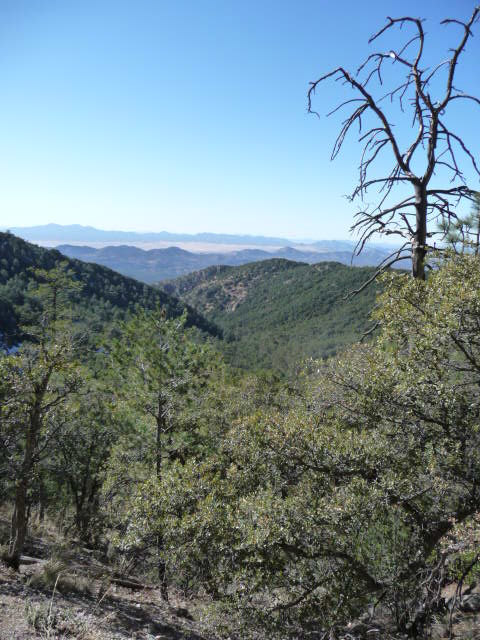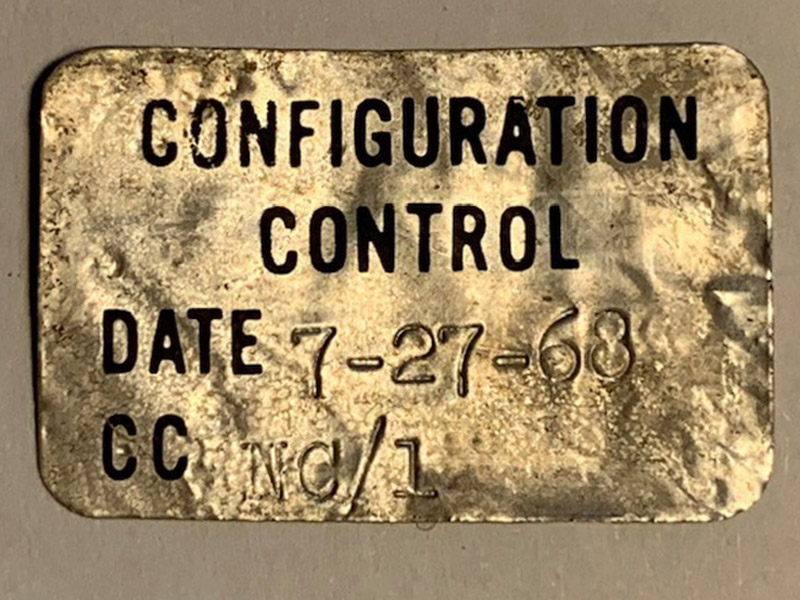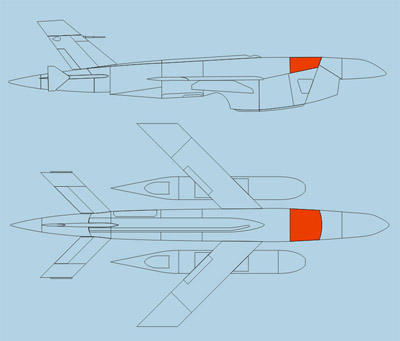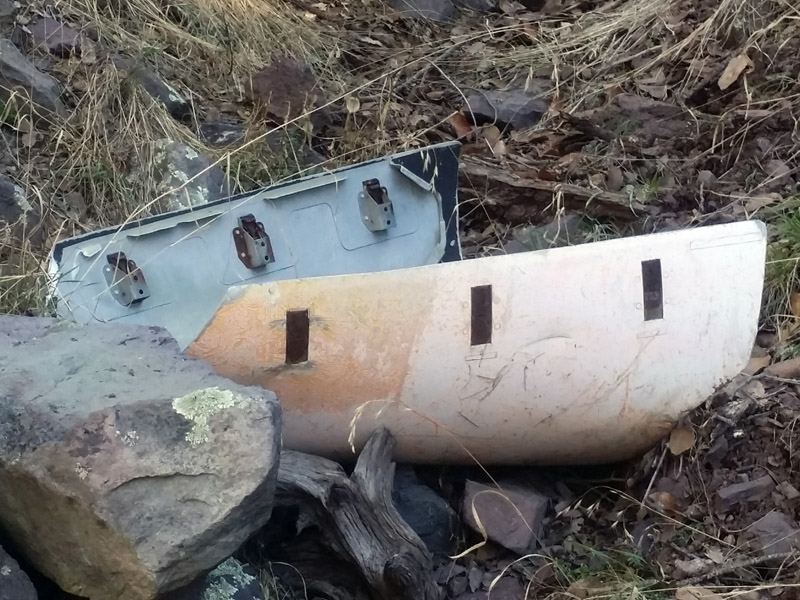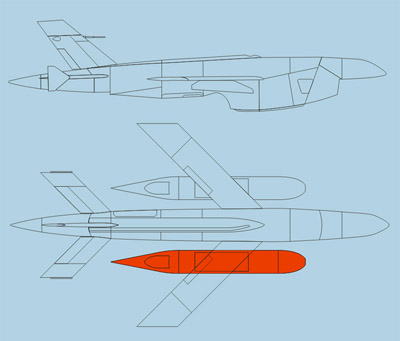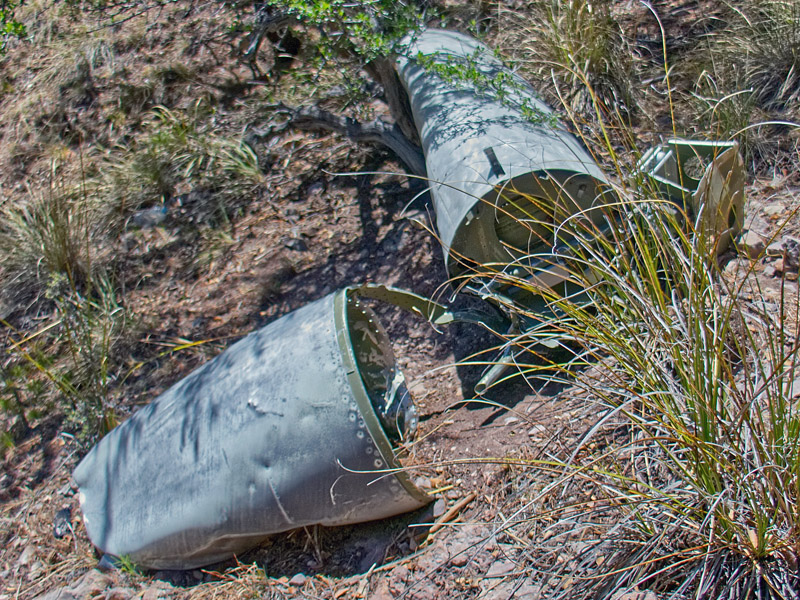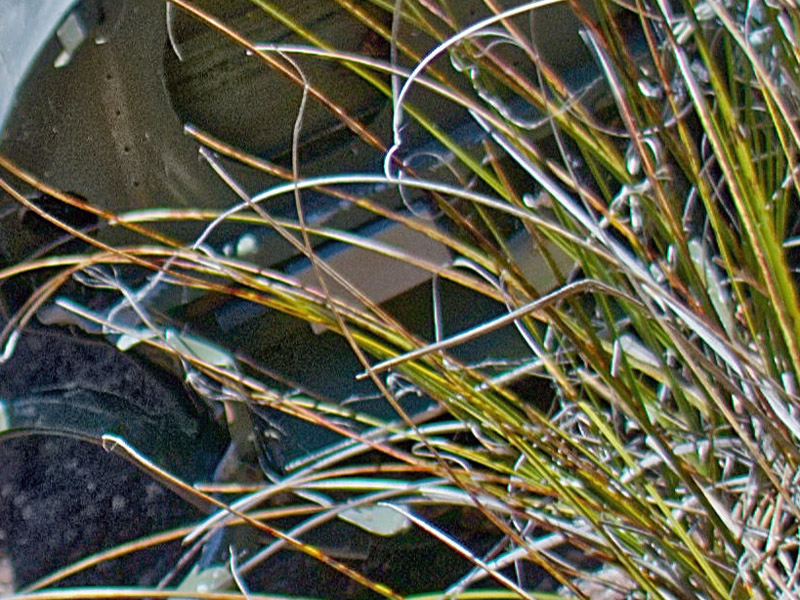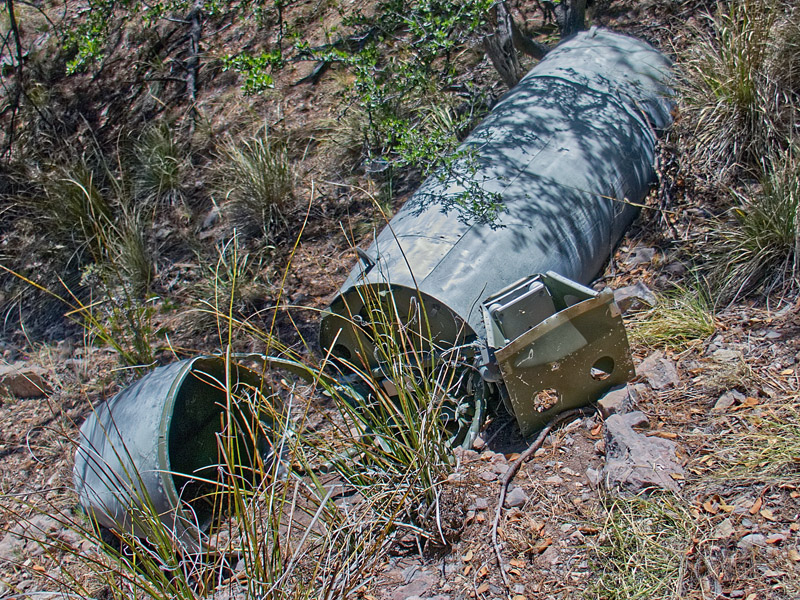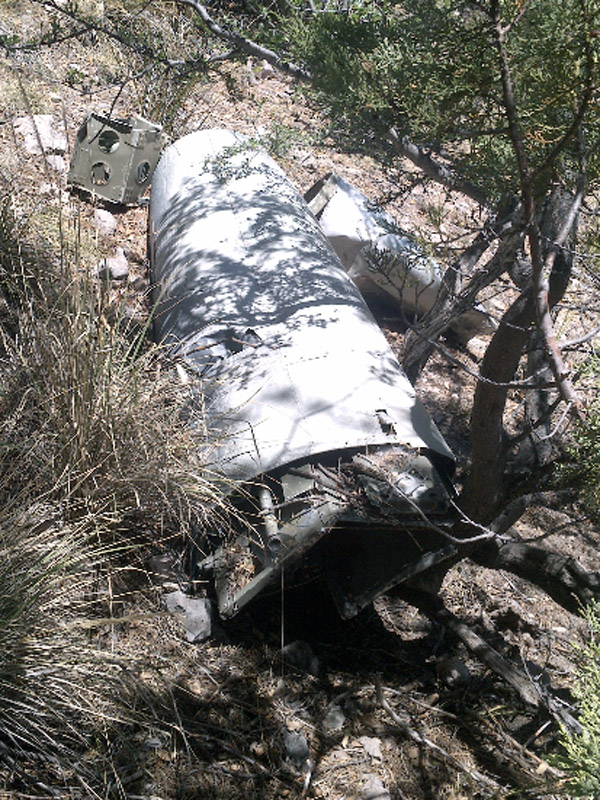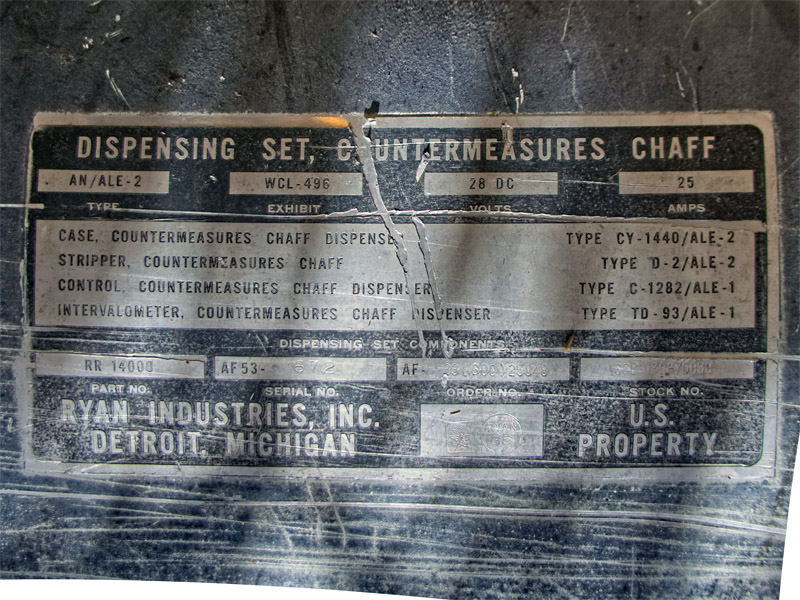Fort Huachuca is at the north end of the range, and Davis Monthan AFB is just 70 miles away. 'Lightning Bugs', on page 154, reports about Model 147NA/NC operations: "Proficiency training flights were staged out of Ft. Huachaca, Arizona, and some out of Eglin with good success devoid of serious operational problems". Craig Kaston reported that it appears that the common training syllabus had the DC-130A/RPV flight originating from Davis-Monthan with RPV air-launch, flight and MARS recovery in the controlled and uncrowded airspace around Fort Huachuca.
Leonard went out for a third look in January 2011, and made a good number of photos. He concluded that "the plane was heading down canyon and snagged a tree, putting the drone into the ground. Must have been moving pretty quick to rip off all wings and break the fuselage in half."
Wreck site overview
|
|
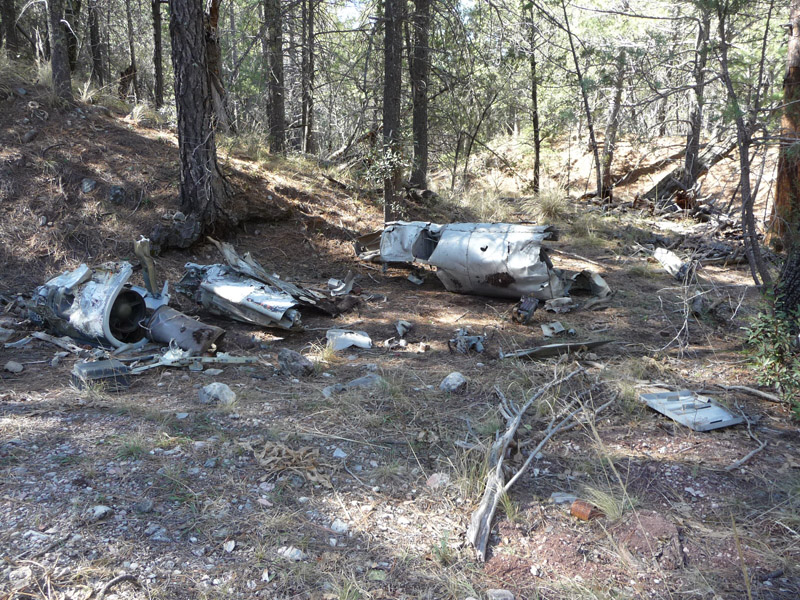
| First an overview of the crash site.
|

| Another view of the crash site, with the wing on the left side.
|

| A large percentage of the airframe and the pods have been found so far.
|
Center fuselage
|
|
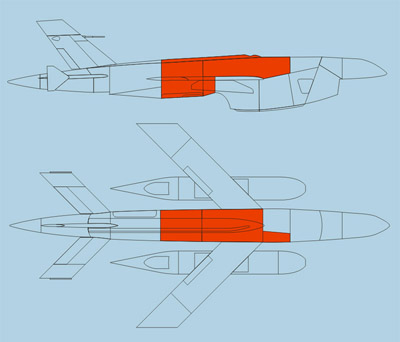
|
|
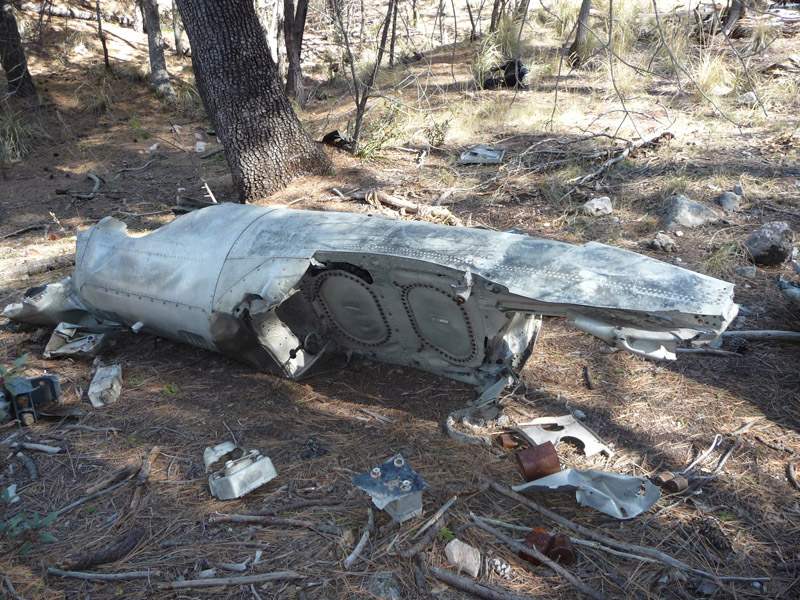
|
This is the center fuselage, by far the largest wreck piece, seen from its right side here. The two large oblong hatches close the main fuel tank on its lower side. The wing would be below the main fuel tank.
This photo shows clearly that it is a Model 147, and not a Model 124 target Firebee. The left 1/3 of the wreck part is the Model 147's 35" rear fuselage extension.
Most of the forward fuselage (seen at the right) is gone, except for the right-hand skin. The 35" fuselage extension (seen at the left) reasonably intact. The right-side skin seems to show faint remains of black paint.
|
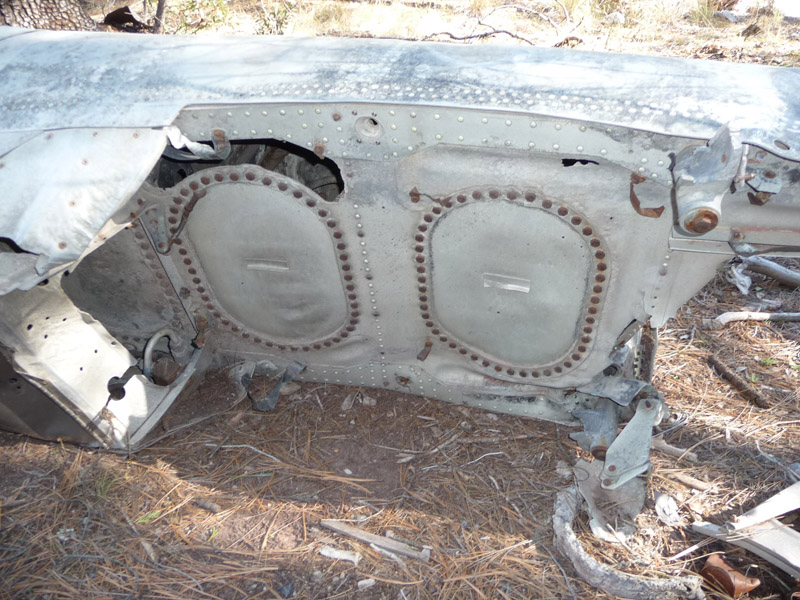
| Close-up of the lower side of the main fuel tank. What appears to be a vertical mounting boss, on the right, is actually the remains of the wing box, that was torn off. A similar broken-off boss can be seen at the bottom. The bolt holes for the rear two wing mountings are clearly visible, between the two hatches.
|
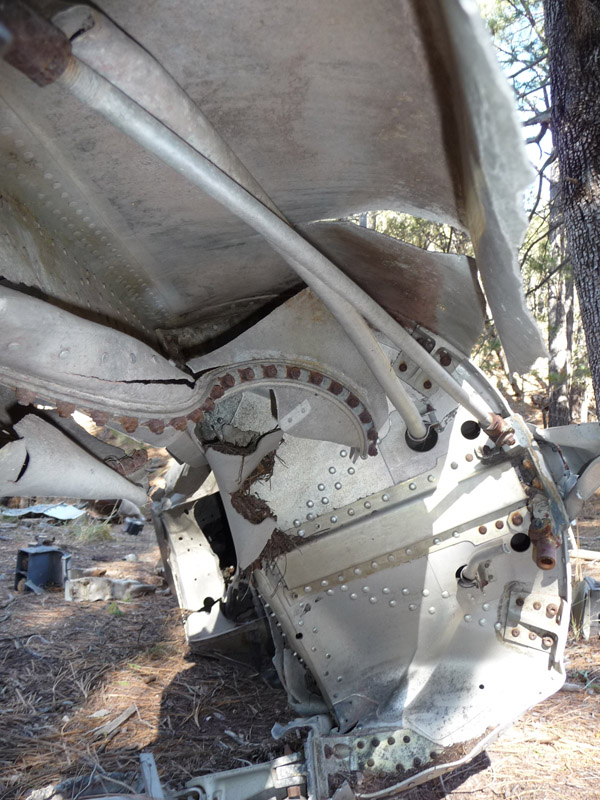
| Close-up of the main fuel tank's front bulkhead, seen from the front.
|
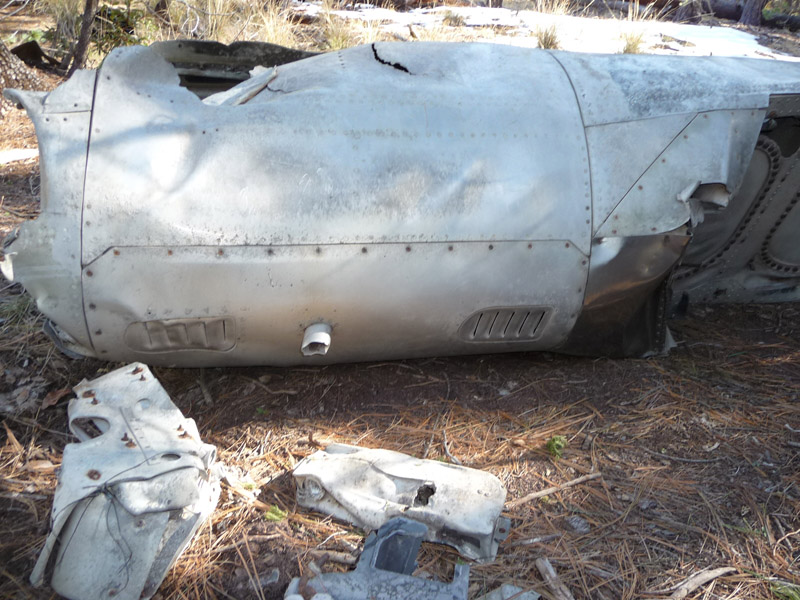
| Close-up of the 35" fuselage extension, with two louver vents and what looks like a fuel dump tube.
|
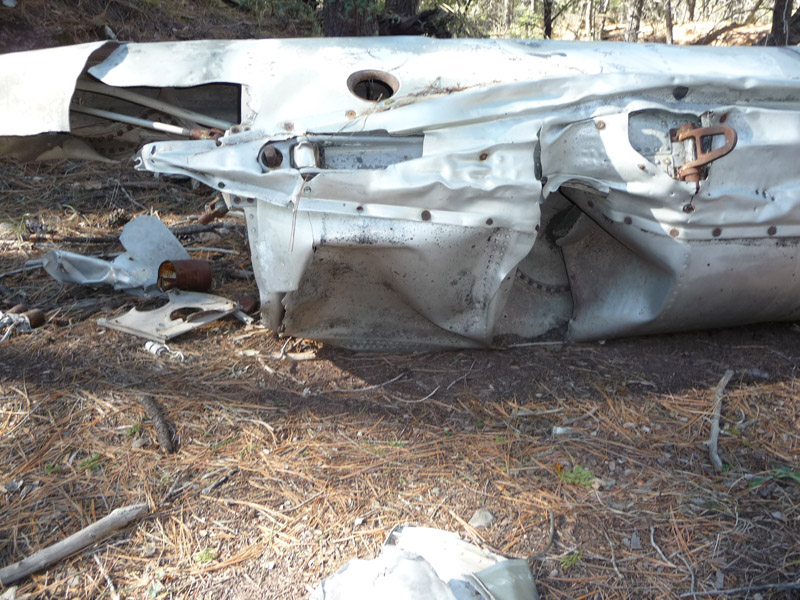
| Moving over to the other side, a top view of the dorsal fairing and the heavily dented left side. It looks like damage from a heavy impact, possibly from hitting a tree.
The best feature for orientation is the dorsal fairing, with a long parachute riser slot. At the very front of the dorsal fairing, a rust-colored pin is visible, this is the rectractable forward shackle pin, in its retracted position.
A very short distance aft shows the main parachute attachment, also the starting point of the slot for the parachute riser. Further aft and to the right is the fueling opening. Further aft again is the main shackle, again rust-colored.
|

| Here the fuselage is rolled to its right, now almost in its 'normal' upright position. It's now visible that the dent is actually torn open, showing one of two large oblong hatches that close the main fuel tank. Below the large dent is where the wing would be mounted.
|
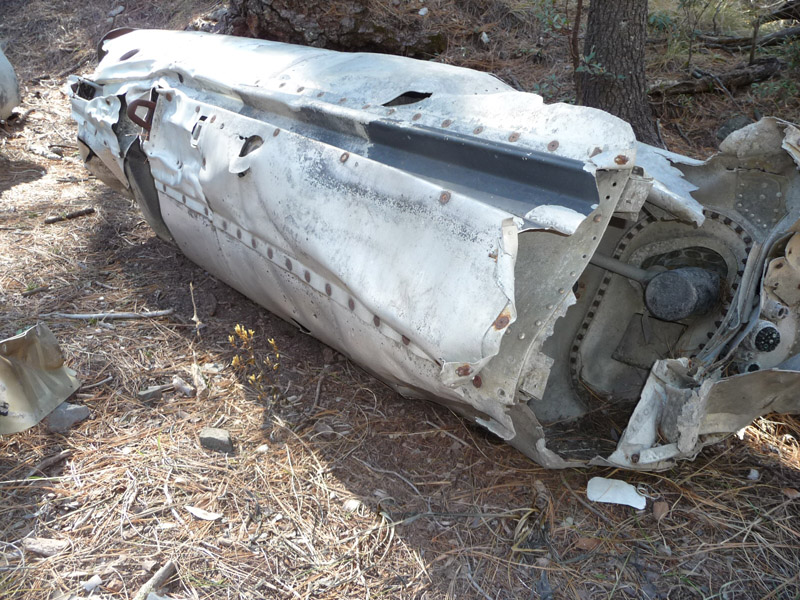
| A rear view of the 35" fuselage extension, that mainly serves as a fuel tank. It is closed off by a bulkhead, with another oblong hatch. A black cylinder projects from this hatch.
The black paint in the rear of the parachute riser slot is peculiar, considering that the remainder of the airframe is almost bare metal.
|

| A view straight from the rear, looking inside the fuel tank of the 35" fuselage extension. Another fuel tank hatch is visible at the bottom, center in the photo.
|
Rear fuselage
|
|
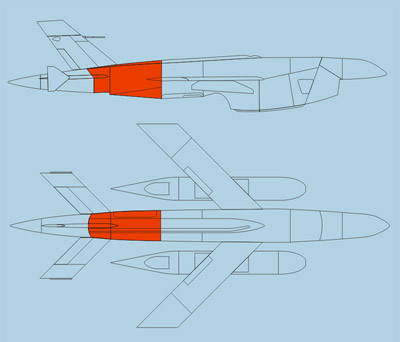
|
|
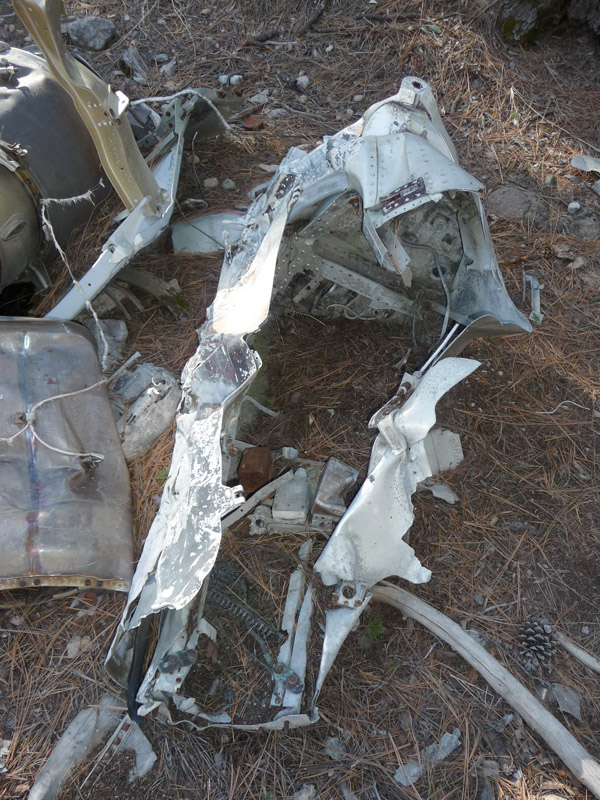
| Here's the last part of the rear fuselage, seen from below. This is the avionics compartment. The avionics compartment door is present, but we're seeing its edge only. An avionics compartment door latch is seen in the 1 o'clock position, slightly rusty. Possibly a second latch is seen just right of center photo, also slightly rusty.
|
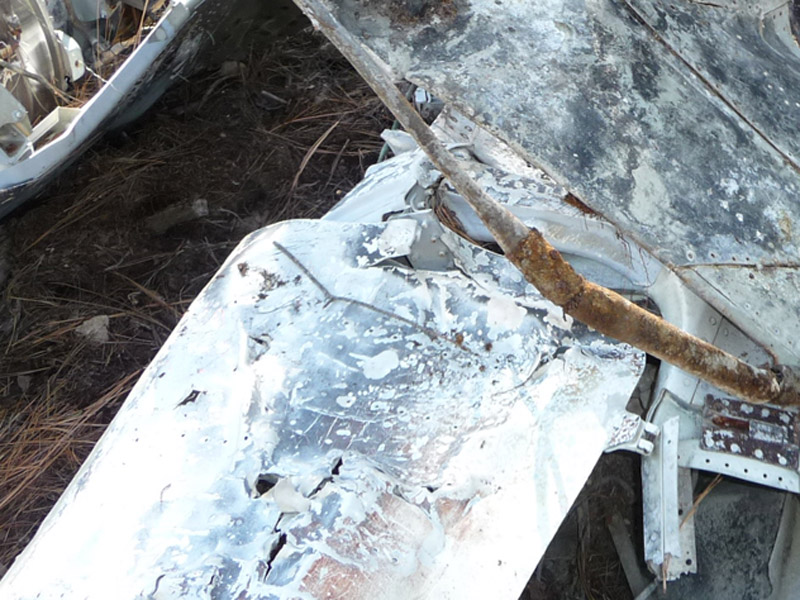
| This angle shows the avionics compartment door perfectly. One door clasp and the matching latch receptacle are visible on the right side.
|
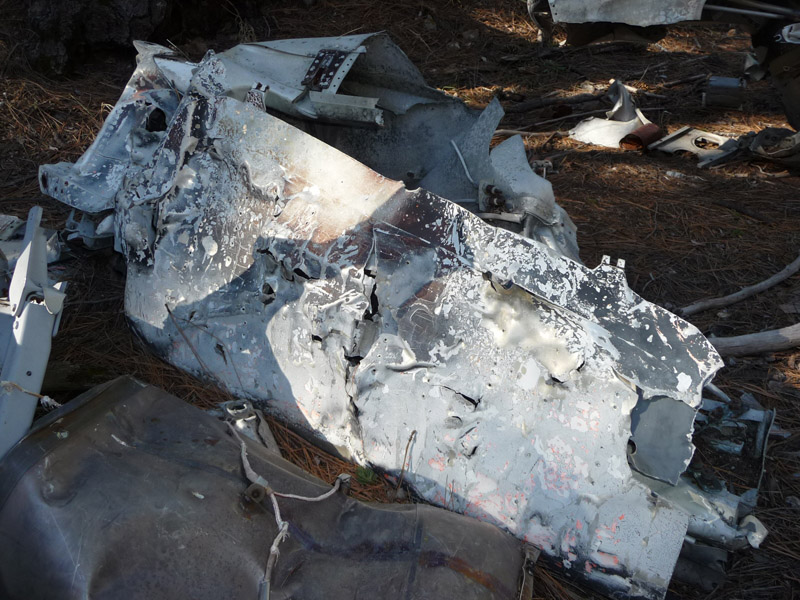
| Moving to the left, the avionics compartment door is again perfectly in view. We can now see that it is badly damaged.
|
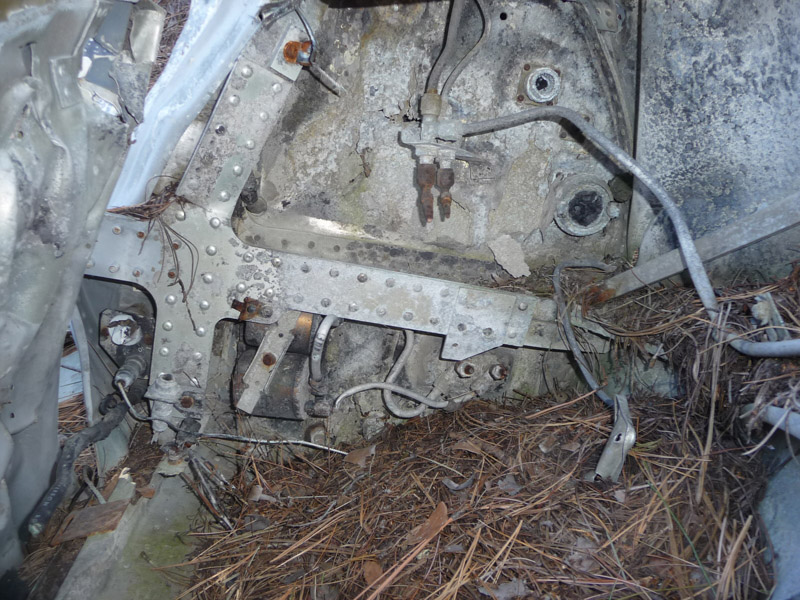
| The rear bulkhead of the avionics compartment, seen from the front.
|
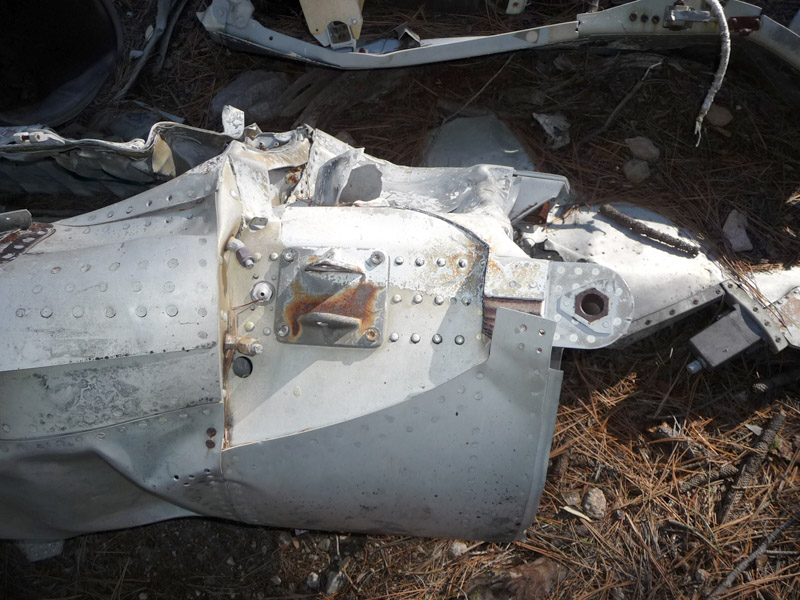
| Moving to the rear of this wreck piece, we see the cut-out in the aerodynamic contour was made to mount the bracket for the JATO-bottle's forward end. It's slightly rusted.
|
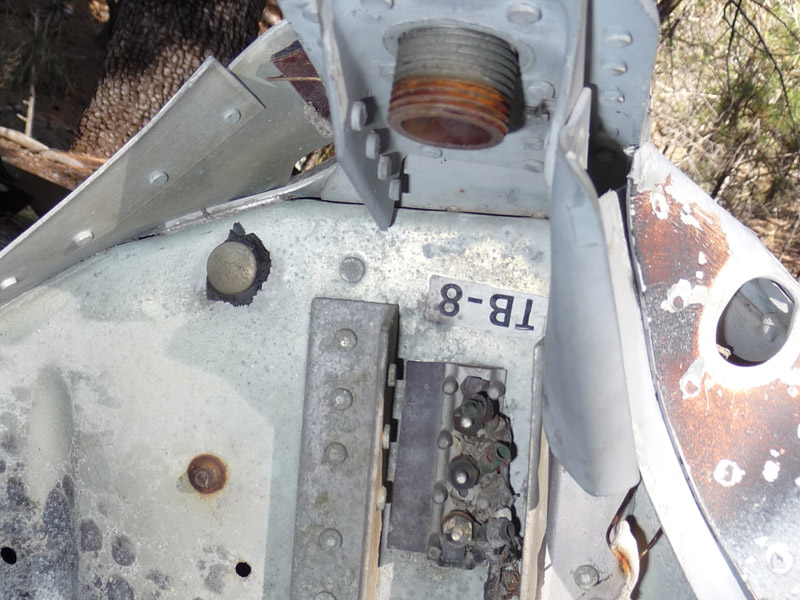
| Concluding, a rear view of the rear bulkhead of the rear fuselage.
|
Main parachute cone
|
|

|
|
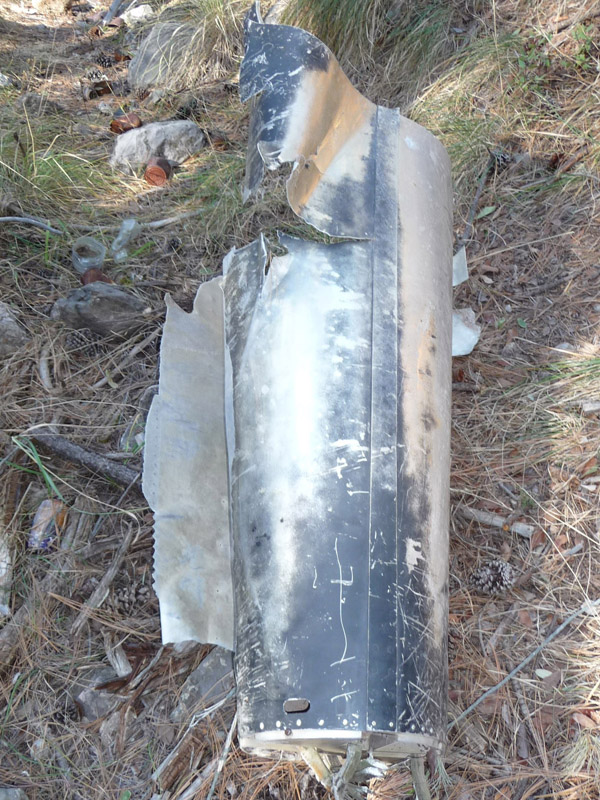
| The main parachute cone is mounted on the previously shown part. It's made of sheet aluminum, and the black paint is reasonably well preserved. This part would be lost if a normal parachute letdown was initiated, therefore we can conclude the main parachute was never deployed.
|
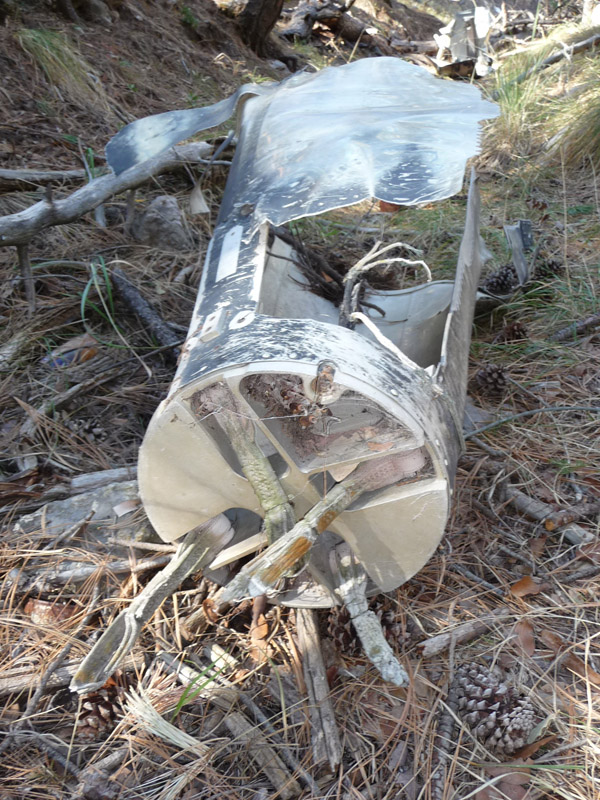
| The torn drogue chute risers on the rear bulkhead of the main parachute cone suggest that the drogue chute was deployed, but torn off, possibly due to excessive speed?
|
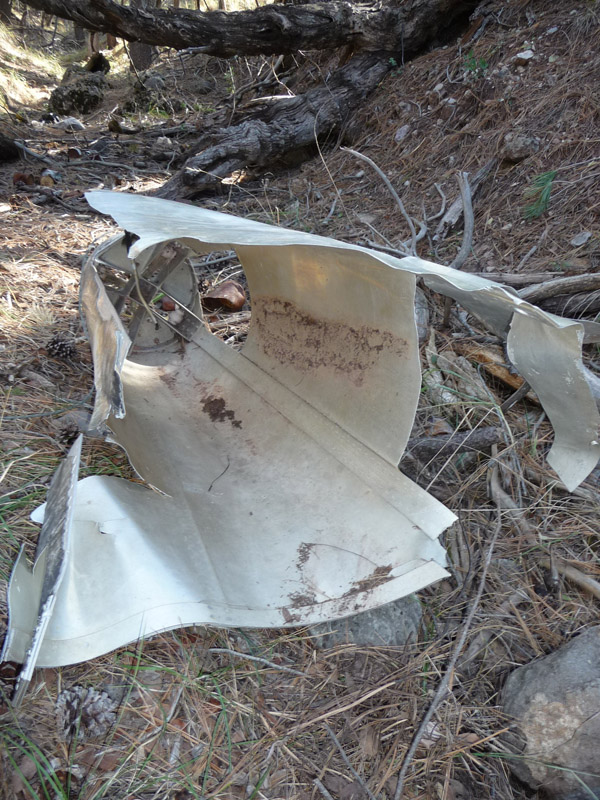
| A view from the front side shows the clean area for main chute stowage. I guess the huge main chute was taken as a souvenir.
|
Center nacelle with engine
|
|

|
|
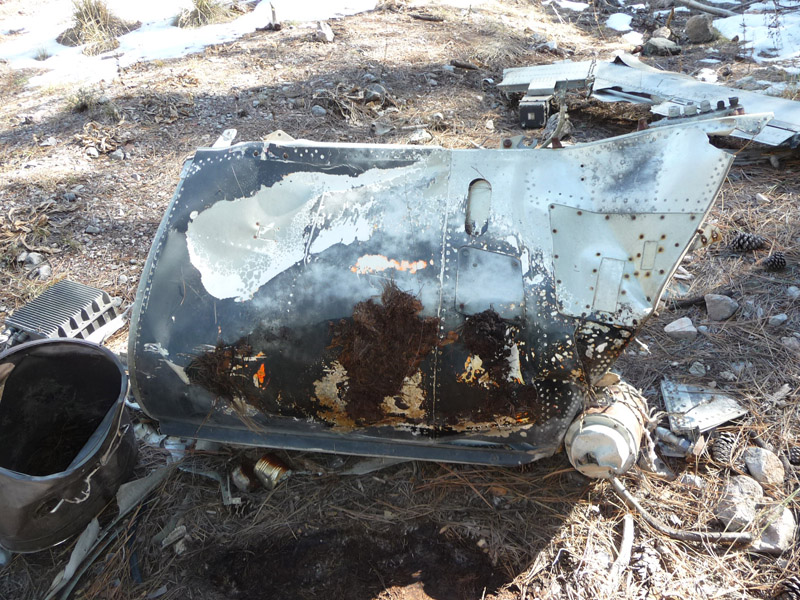
| The center nacelle, in its upright position, seen from the right. As can be seen from the patch on the ground, it was lying on the right side originally. Compared to other wreck parts, the nacelle side still has a lot of black paint remaining.
|
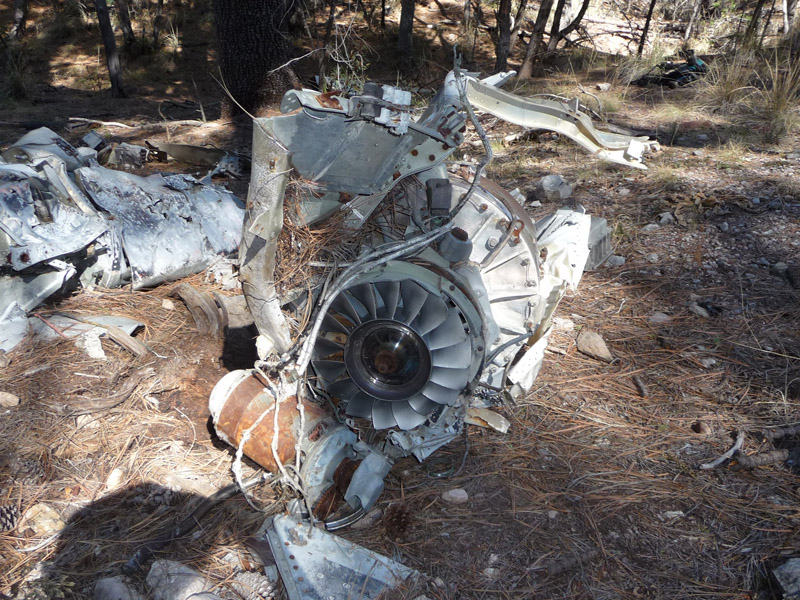
| Moving to the right, viewing the nacelle from the front, with the compressor section of the engine. In the same plane as the compressor, one of the heavy frames inside the nacelle is visible, to withstand belly landings.
The rusty cylinder near the compressor face must be the generator, that is mounted in a bullet fairing at the front of the engine.
|
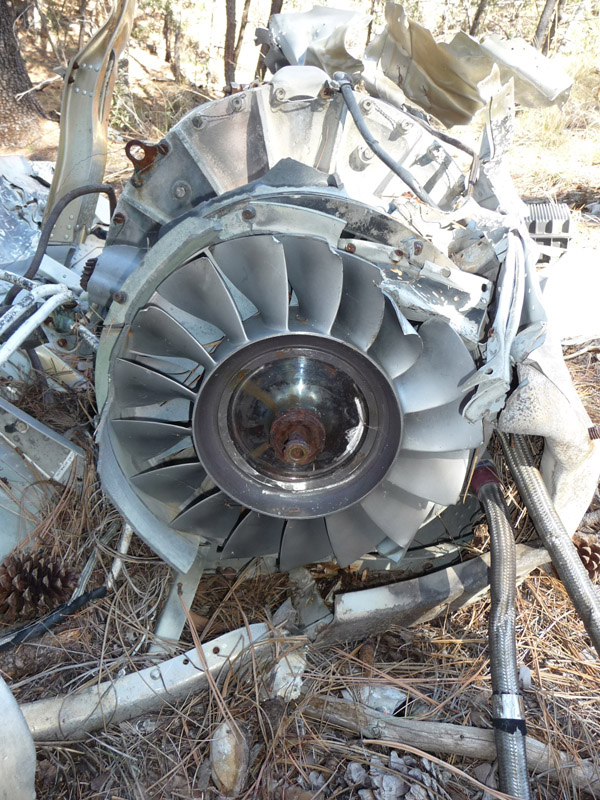
| A close-up of the compressor, with the nacelle still on its side, hence the different picture. Craig Kaston commented that the engine first stage compressor does not show rotational damage (like curled blade edges) which would indicate that the engine was not running at the time of ground impact.
|
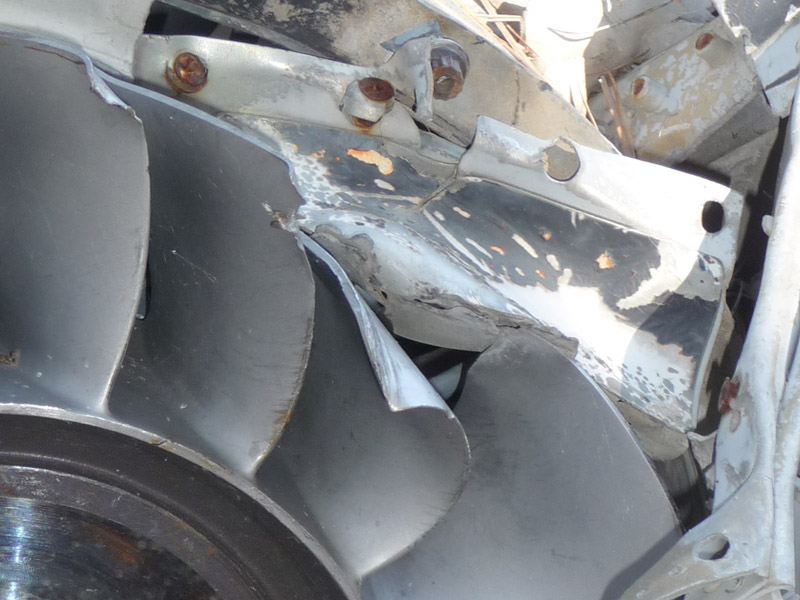
| Close-up of the compressor blades, showing a clear lack of rotational damage, but with a piece of aluminum jammed between the blades. It shows orange and black paint again.
|
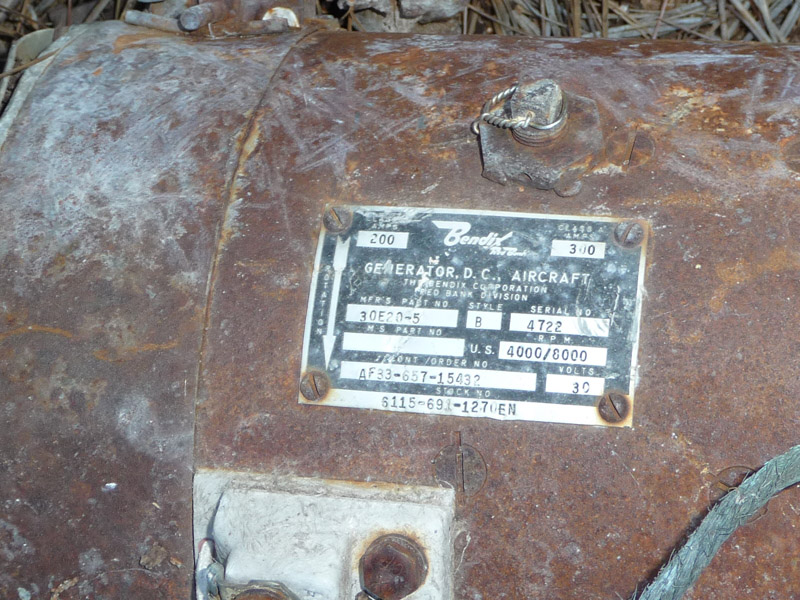
| The Bendix generator still had its data plate.
|
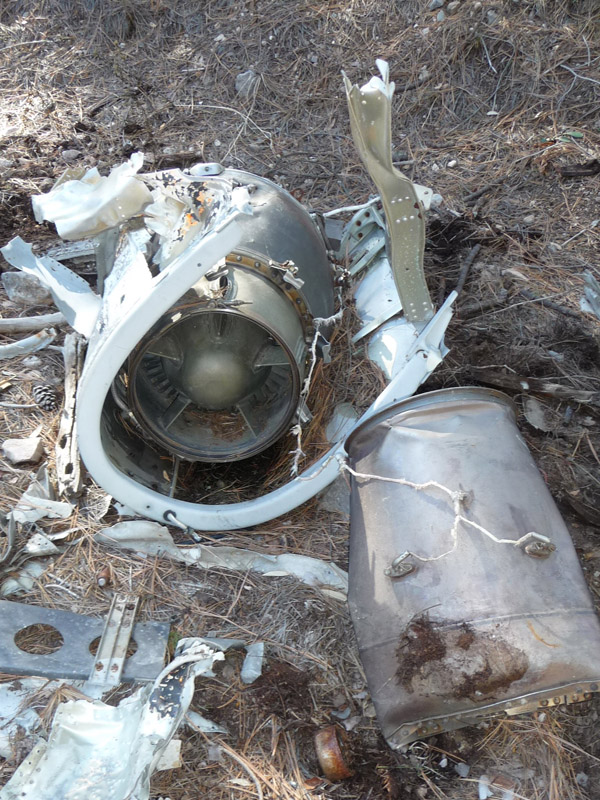
| Walking around to the other side, the rear of the nacelle, with the turbine section of the engine. To the right the exhaust duct, with two temperature probes and their wiring.
|
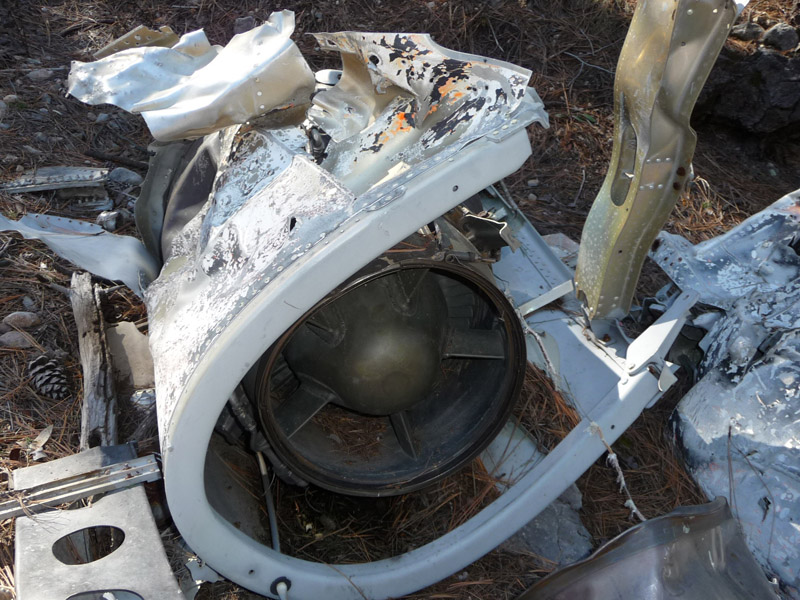
| The top left corner of the center nacelle again shows black over orange paint.
|
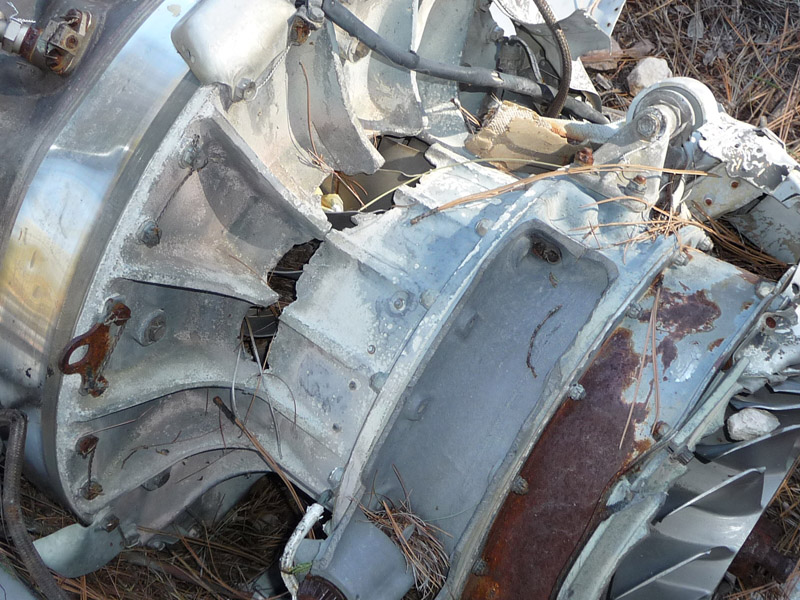
| Looking down into the nacelle, we see the whole compressor section, with one axial stage and one centrifugal stage.
|
Aft nacelle
|
|
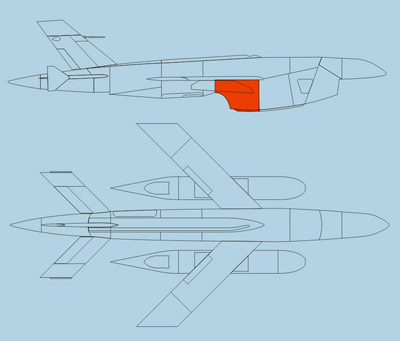
|
|
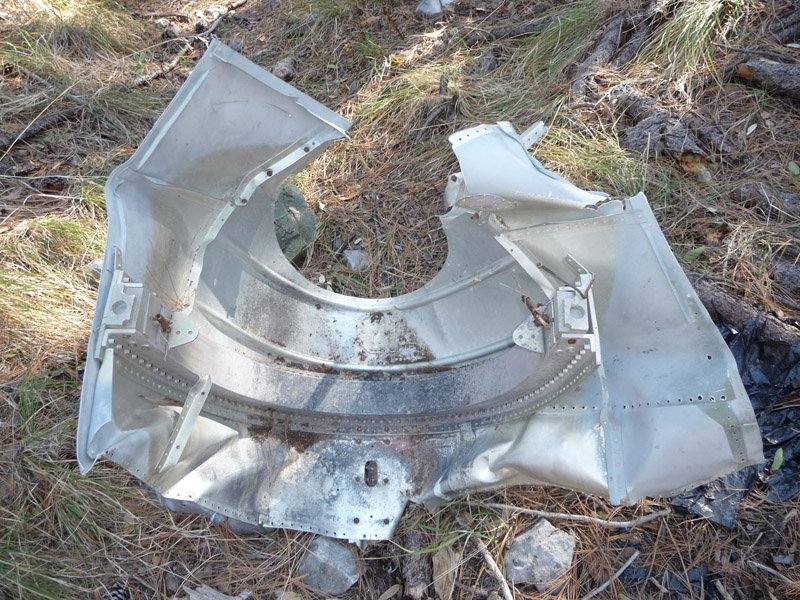
| The aft section of the nacelle is relatively intact. This inside view shows one of the heavy frames in the nacelle, designed to survive belly landings under the main chute. This was the primary landing method before MARS was developed.
|
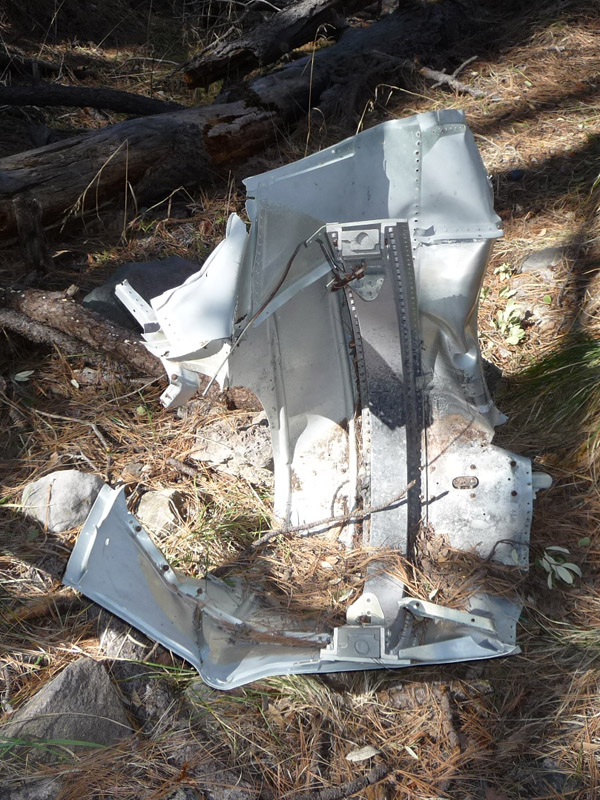
| Moving to the left compared to the previous photo, another view of the inside of the aft section of the engine nacelle.
|
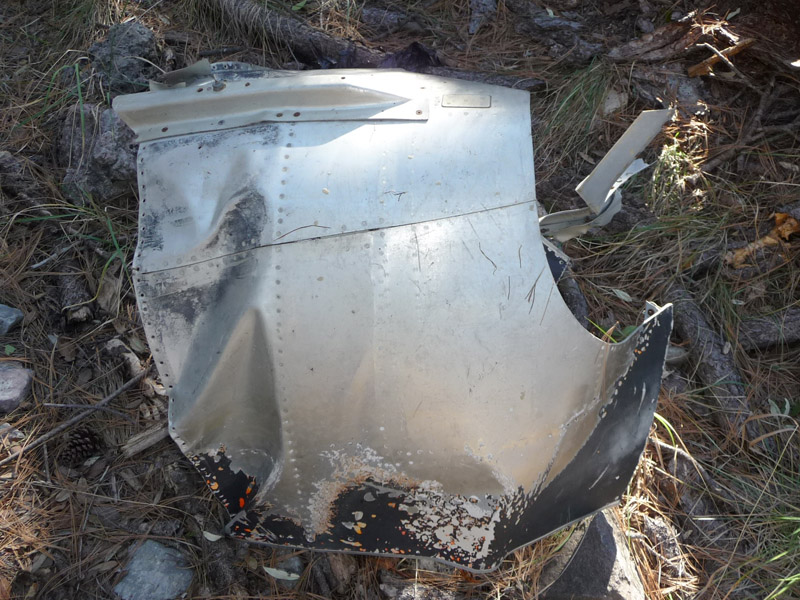
| Once turned over, the right exterior side is seen. The aft part of the belly skid is clean and undamaged. The paint remains are orange overpainted with black.
|
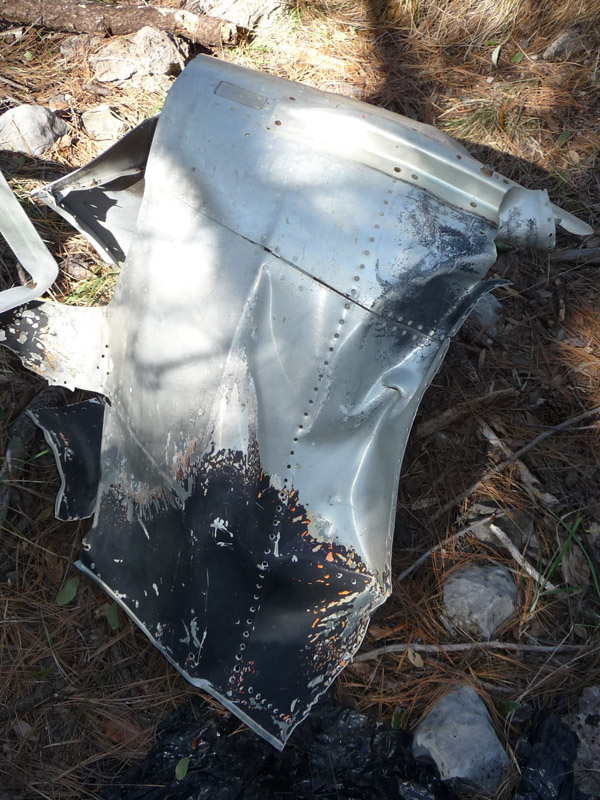
| The left exterior shows similar paint remains, mostly on its top edge, now at the bottom of the photo.
|

| The paint of the left side also clearly shows orange overpainted with black.
|
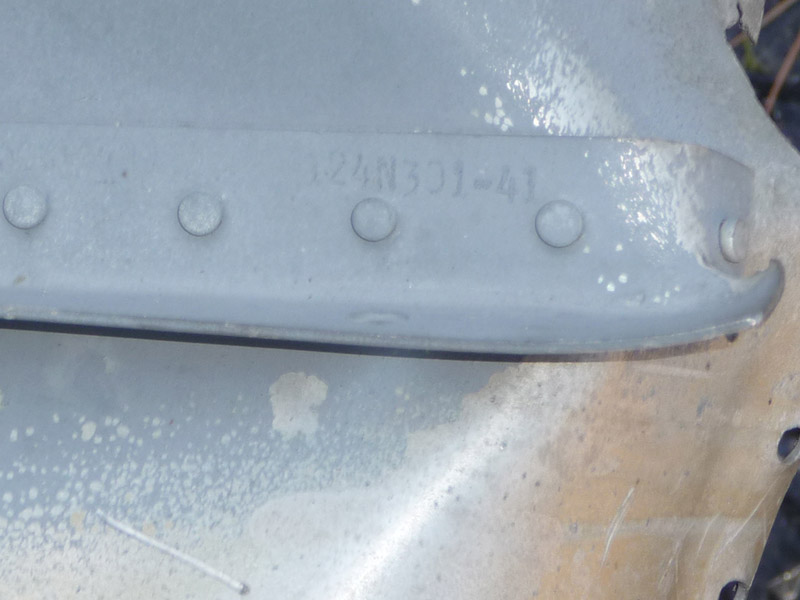
| More proof that this Model 147 was converted from a Model 124 airframe: part number '124N301-41'.
|
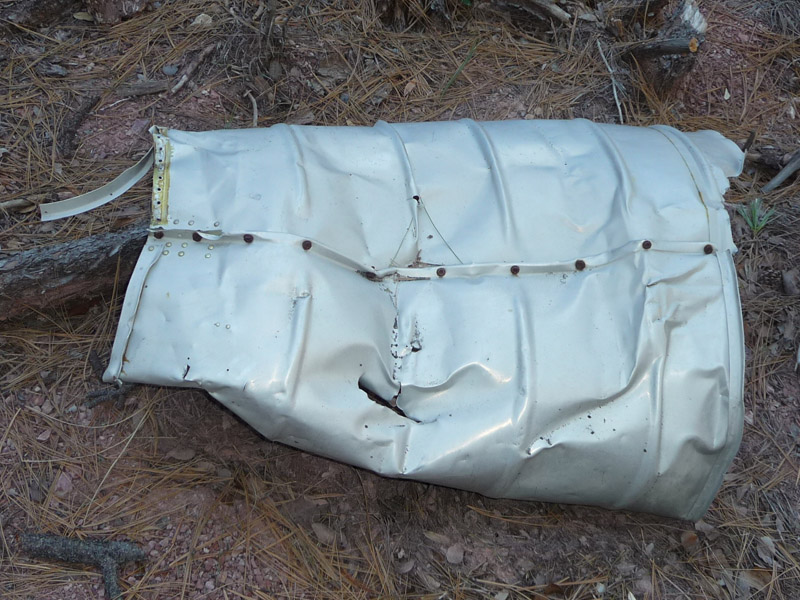
| This part was found elsewhere on the wreck site, about 150' upstream. Craig Kaston recognized this part as the engine heat shroud assembly, that is installed over the exhaust duct, inside the aft nacelle. The shroud splits horizontally. On the wider side (connecting to the turbine section), the flange is extended on the upper half of the shroud. Therefore, this image shows the right side.
|
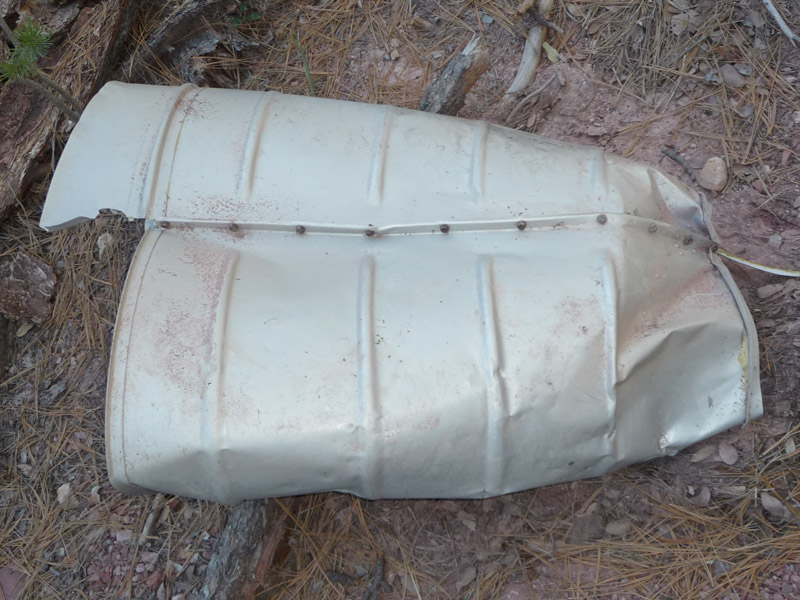
| Here the shroud is rotated 180 degrees, showing the left side.
|
Right plus center wing
|
|
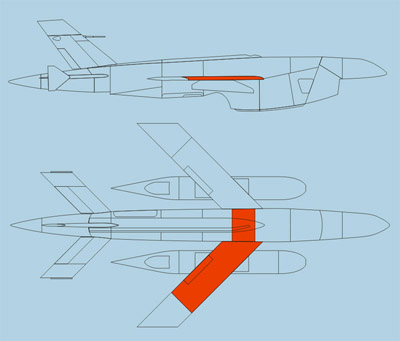
|
|

| The right wing and center wing are still connected. Half of the drooped leading edge is gone. The wing pylon is still attached too.
|

| The rear view shows the aileron still attached, but the rest of the trailing edge is mostly gone. There's just one of four wing mounting point still attached to the center box. The aileron servo box is also still attached to the center wing box.
|
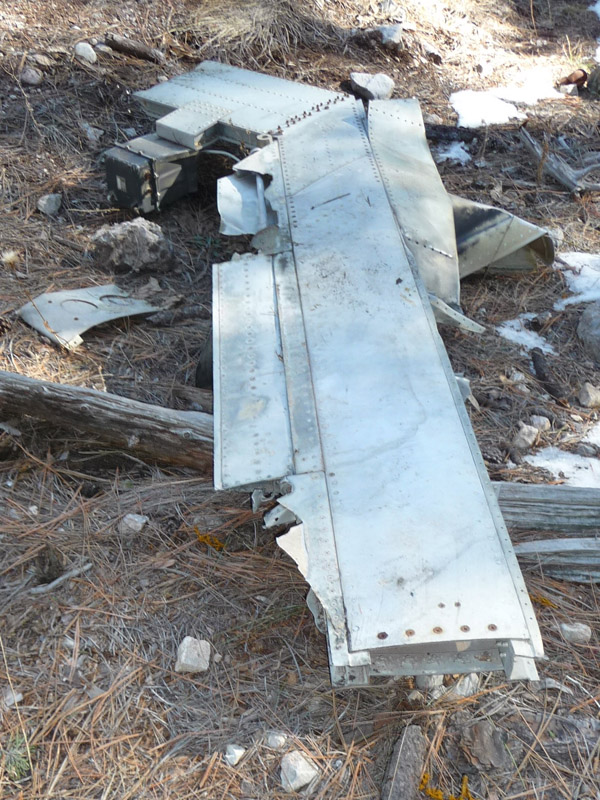
| A view from the wing tip shows the aileron and aileron servo even better. The paint is nearly completely gone.
|
Right-hand wing tip
|
|
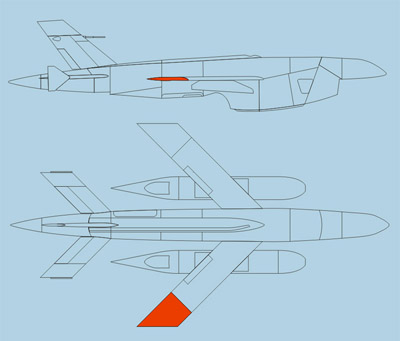
|
|
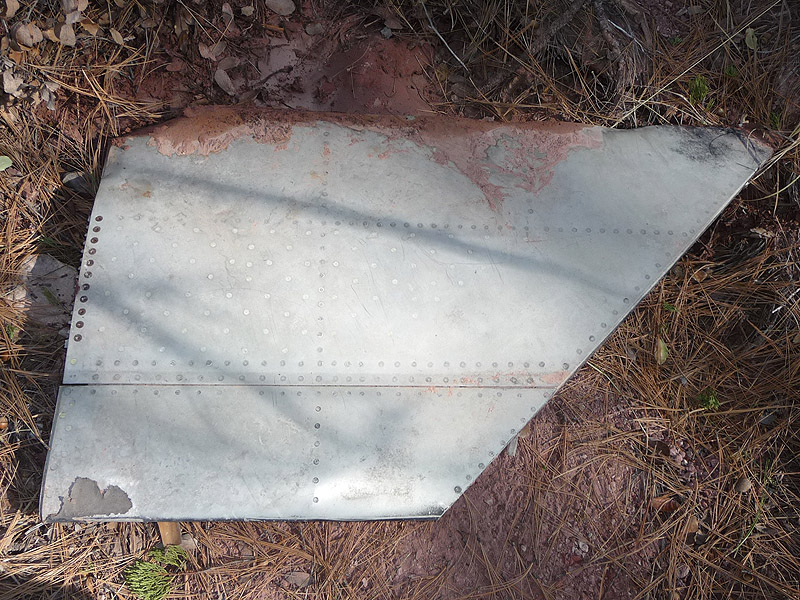
| This is the right-hand removable wing tip, seen from the lower side. It is the longer version of the wing tip, increasing wing area from 36 to 40 square feet.
|
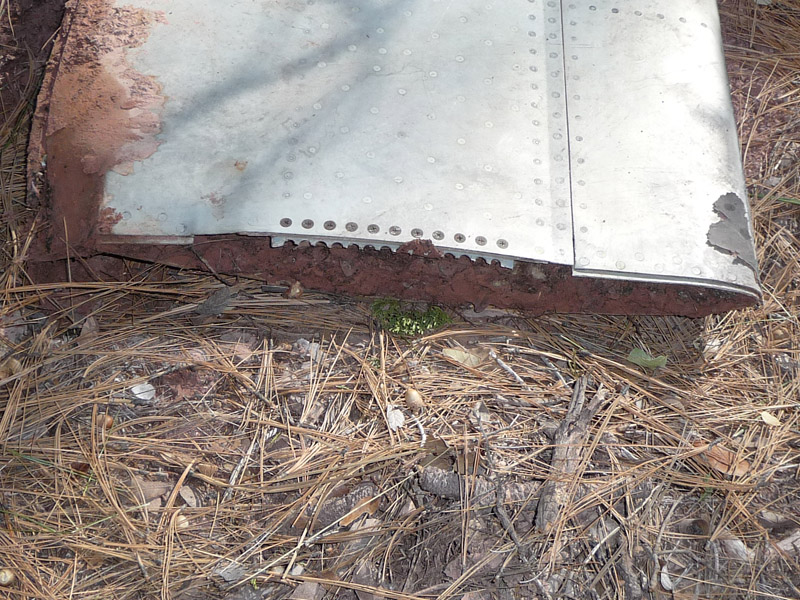
| The perforated strip was probably a built-in weak point of the wing tip mounting, so the wing tip could break off clean in a hard landing.
|
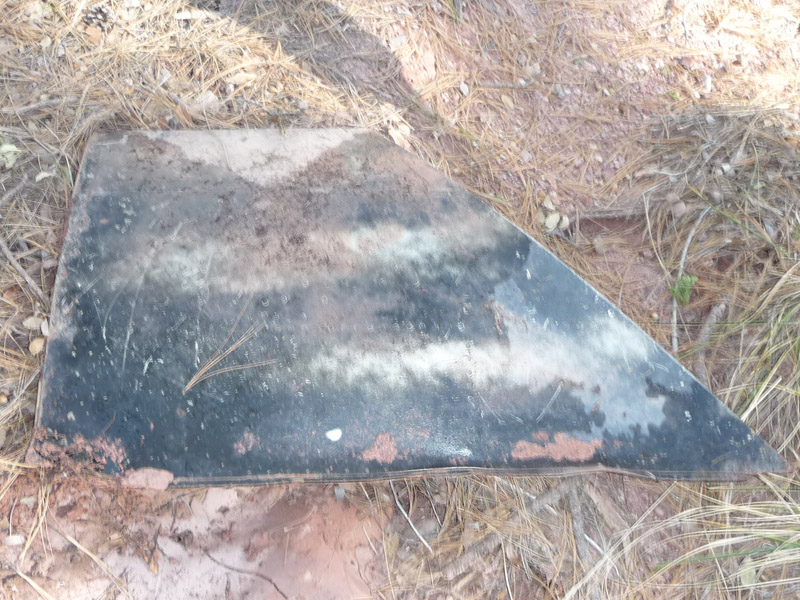
| The lower side still had black paint.
|
Left wing
|
|
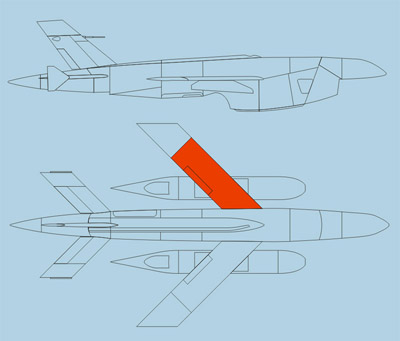
|
|
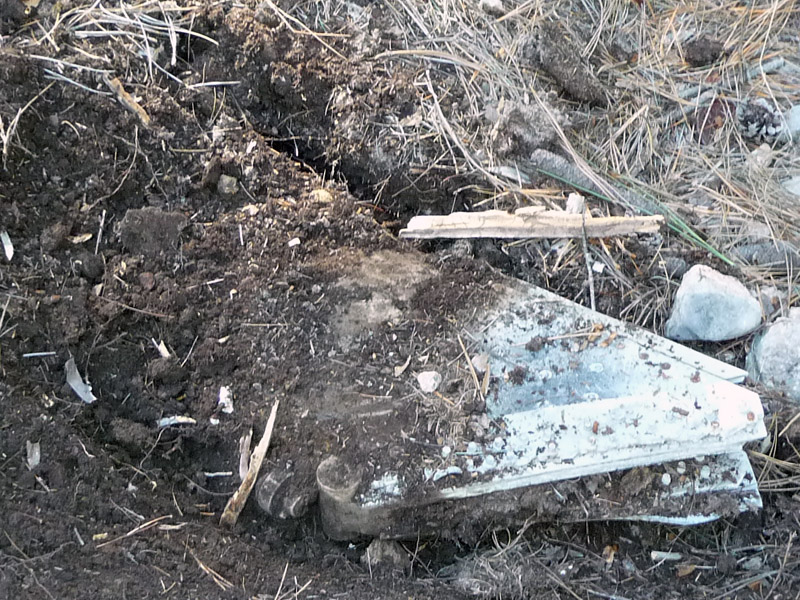
| This looks like the left-hand wing, mostly buried, and missing its leading edge. The fact that is removed from the center section fits with the assumption that the left front side made a heavy contact with (probably) a tree.
|
Vertical tail
|
|
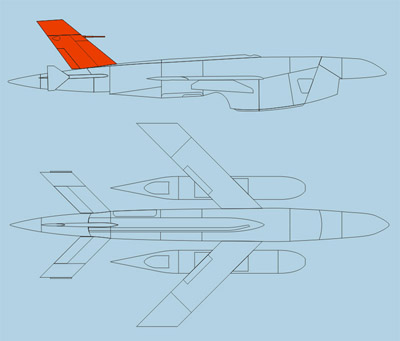
|
|

| The vertical tail lacks it root attachment structure - it was ripped off it seems. Some black paint is still visible.
|
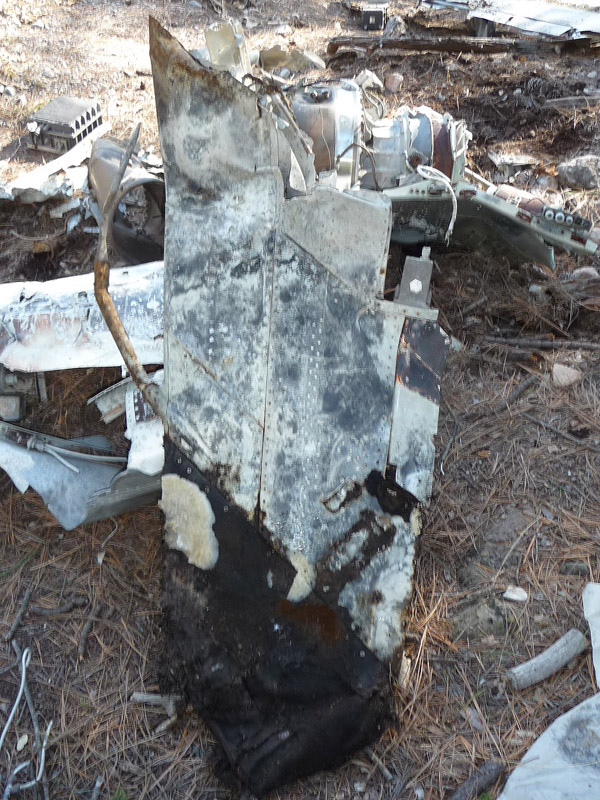
| The vertical tail is repositioned here, and the pitot tube is now dug up.
|
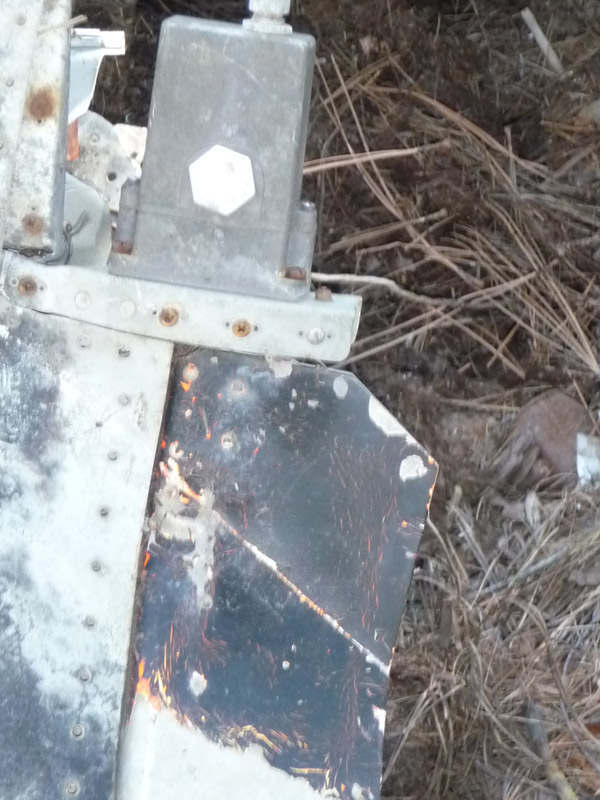
| The rudder actuator is still present. The rudder shows orange and black paint, like the rest of the airframe.
|
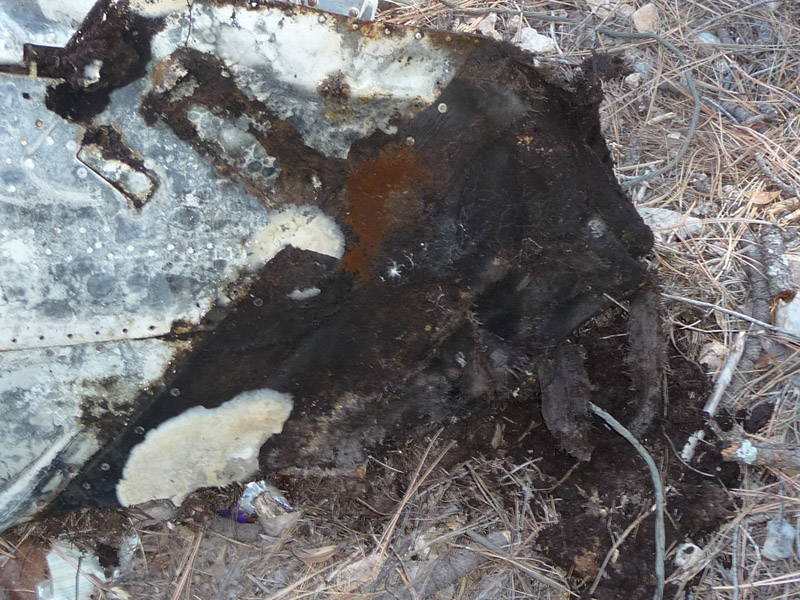
| It's unclear what happened to the glass fiber tip cap. The material is intact where it connects to the aluminum fin structure, but the tip almost looks burned.
|
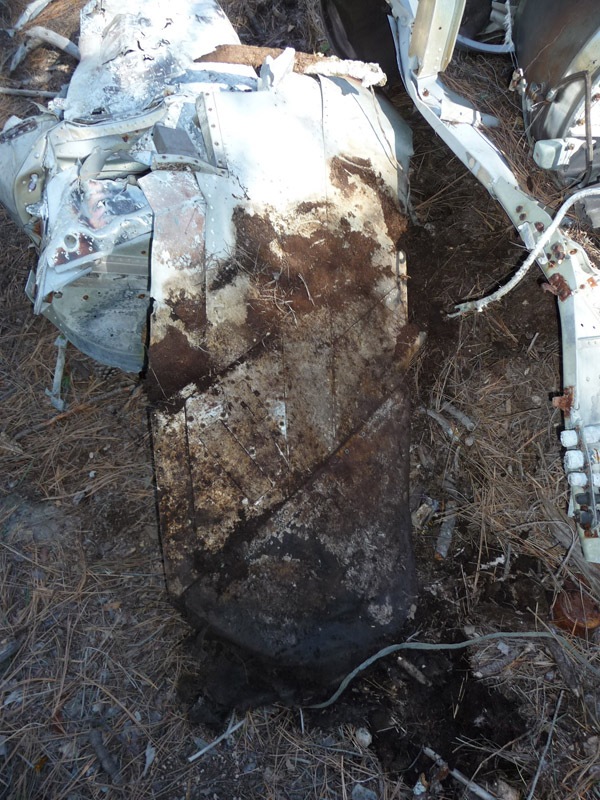
| The vertical tail was turned over, showing the left side. It shows a similar appearance like the right side.
|
Horizontal tail
|
|
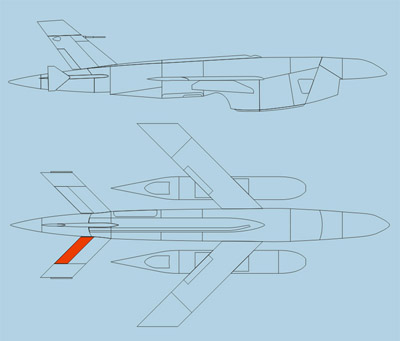
|
|
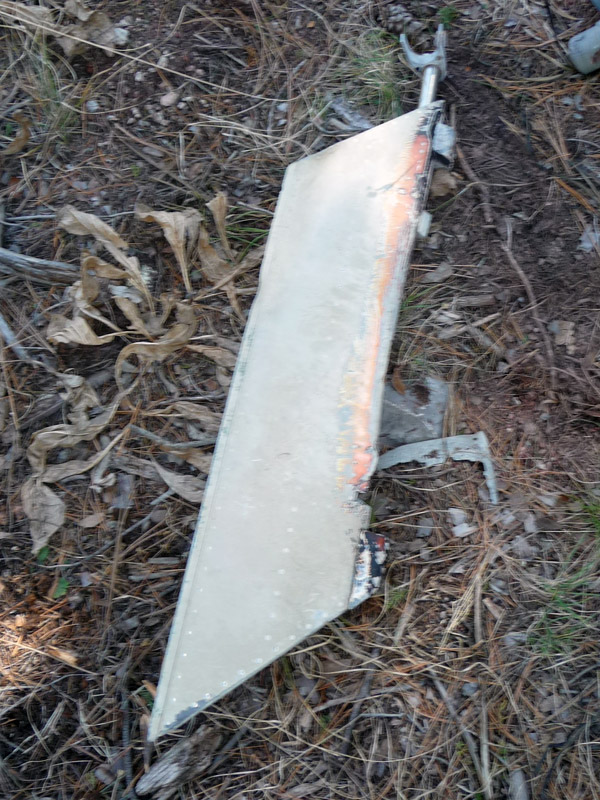
| One of the elevators, compare it with this Tyndall BQM-34A photo. It seems no other parts of the horizontal tail were present.
|
Undetermined airframe parts
|
|
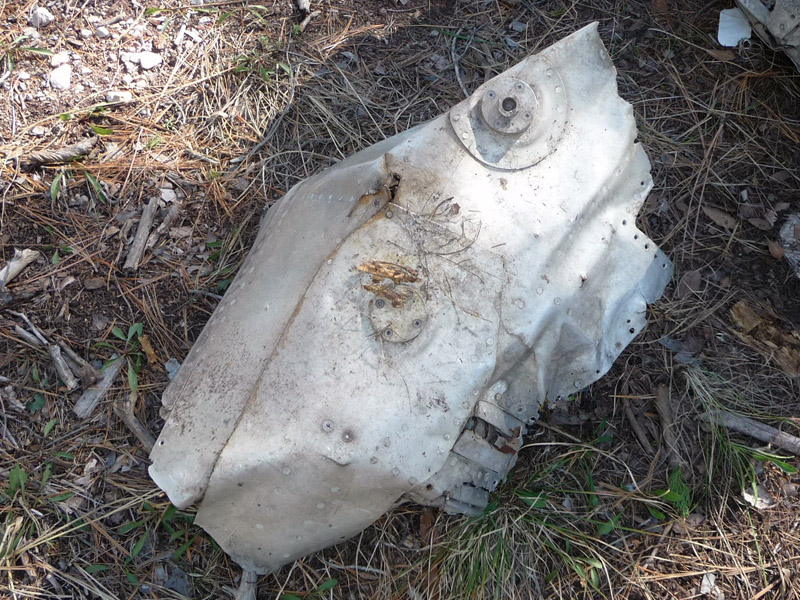
| ?
|
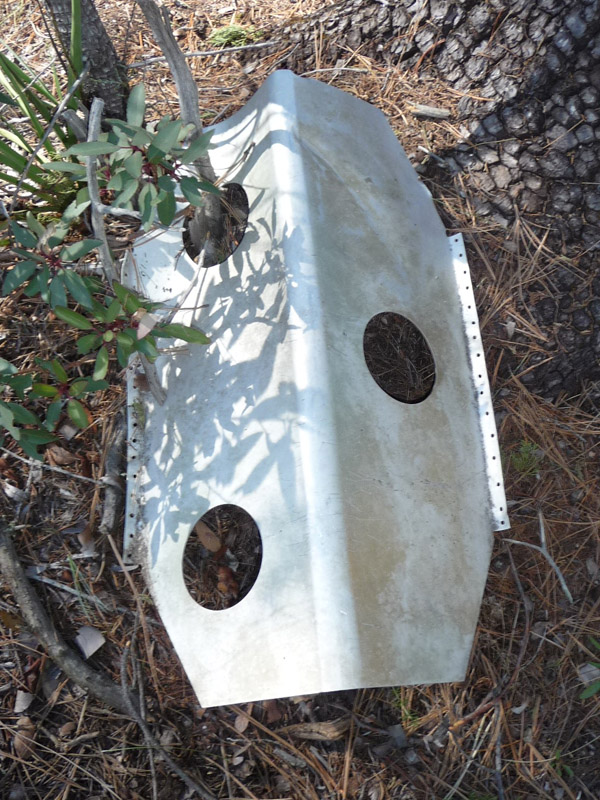
| ?
|
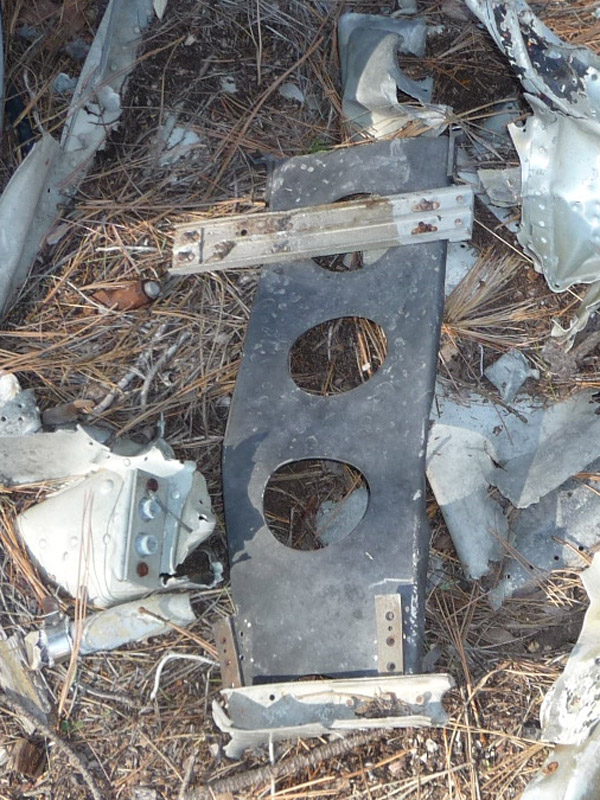
| ?
|
Wing pylons
|
|
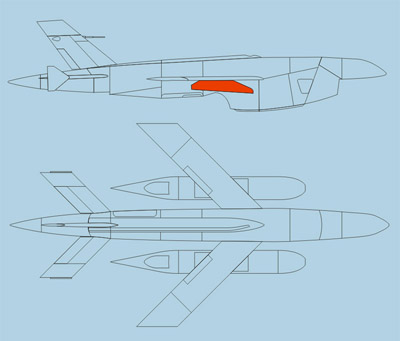
|
|
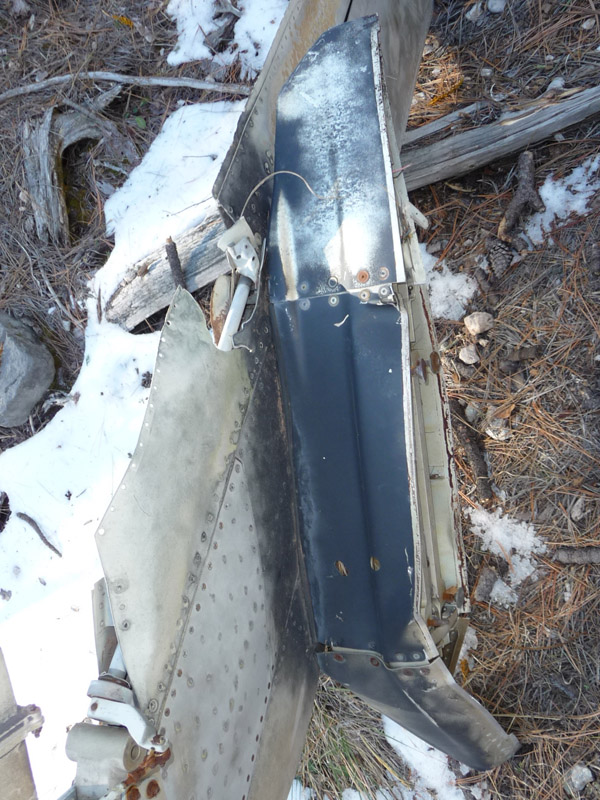
| With the wing turned 90 degrees, a good view of the inboard side of the right pylon. The aileron torque tube can be seen through gaps in the trailing edge.
|
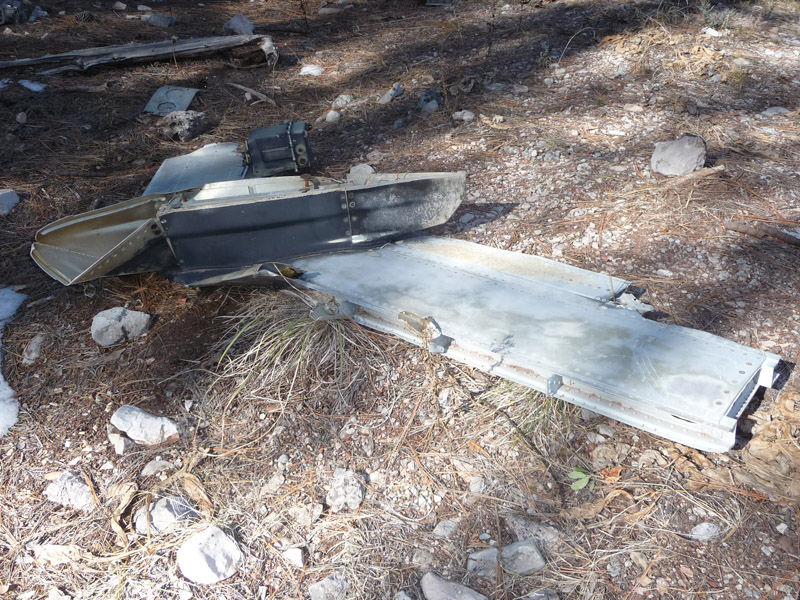
| The wing was turned over, offering a better view of the wing pylon. Most of its black paint is still present.
|
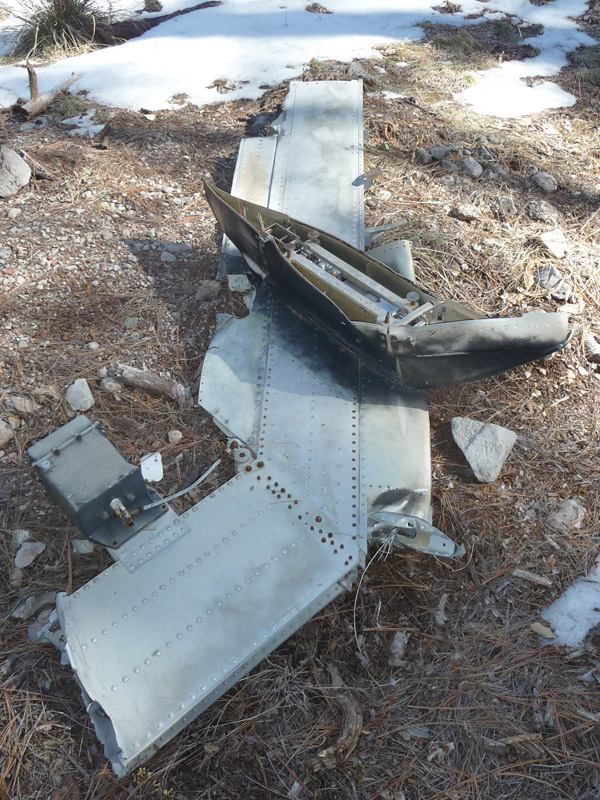
| A top view allows a view inside the pylon fairing, showing the ejector rack.
|

| The left-wing pylon was also present, but it was missing its nose fairing.
|
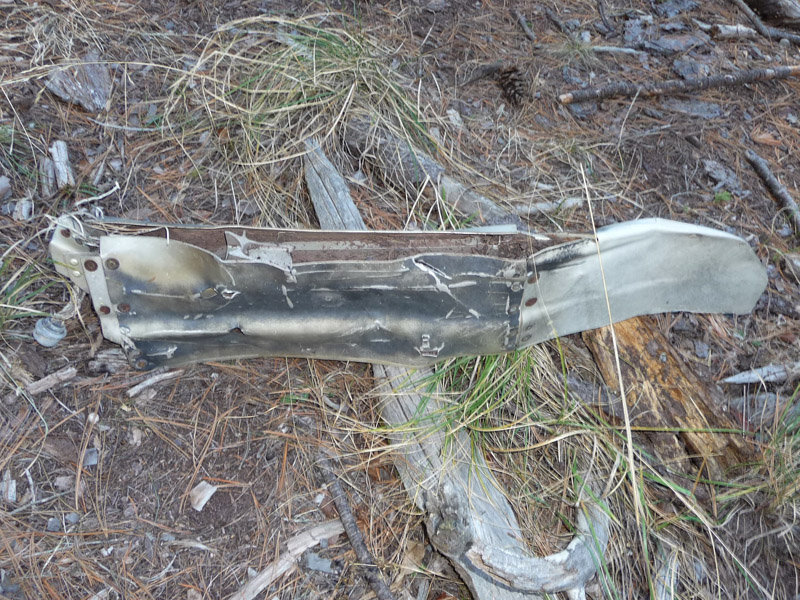
| The left pylon, set upright.
|
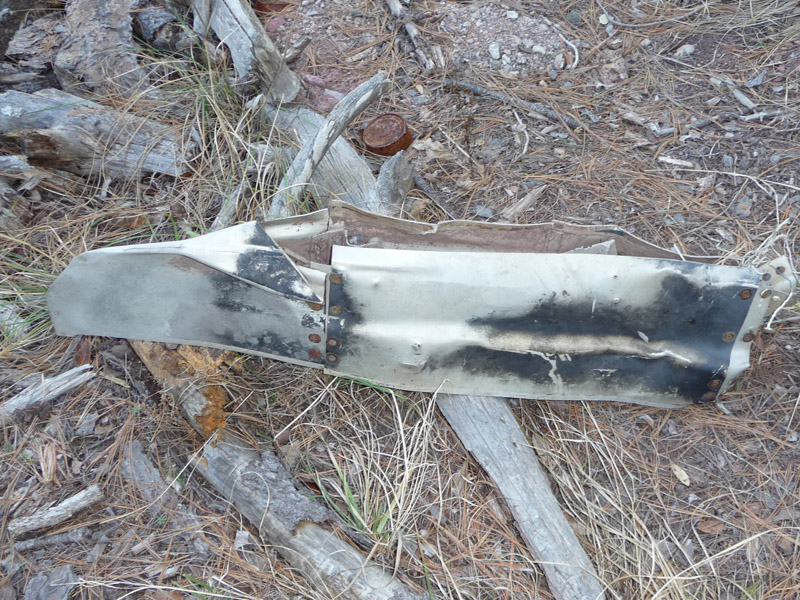
| The left pylon, seen from its inboard side.
|
Systems and electronics
|
|
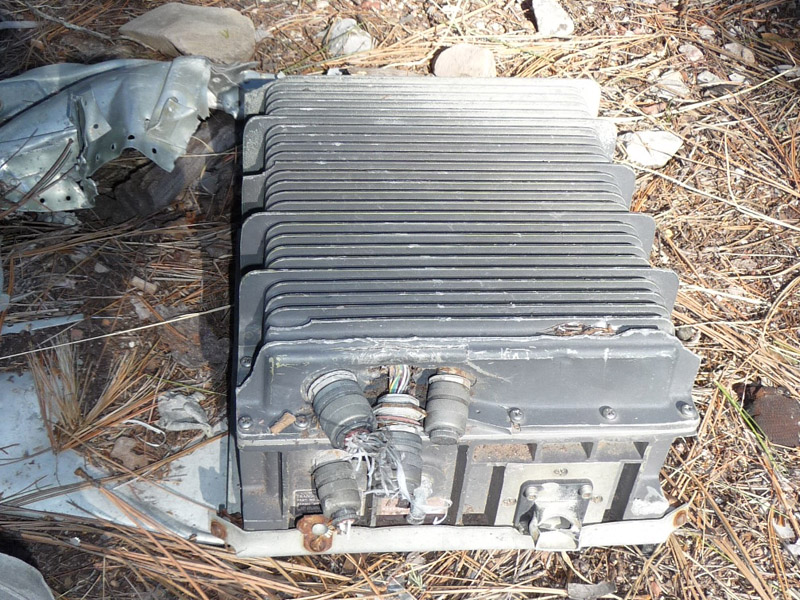
| One of the larger electronics has lots of cooling ribs.
|
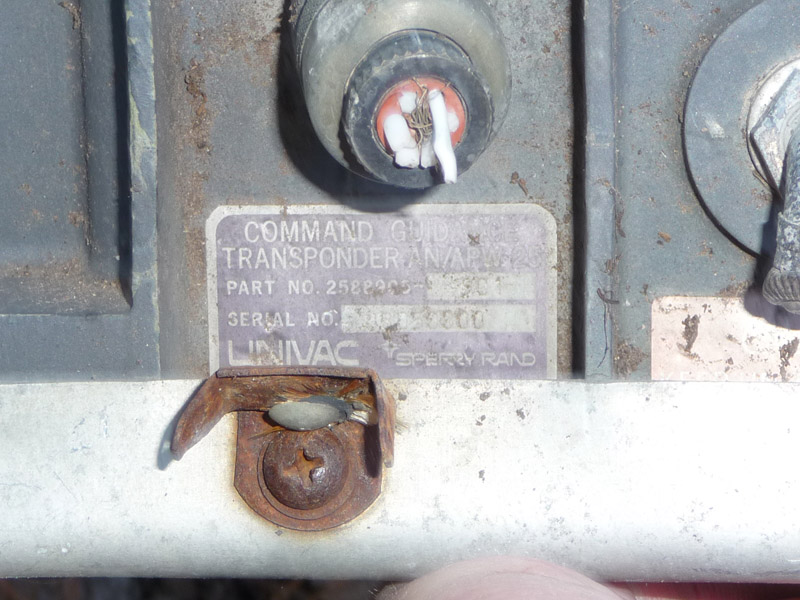
| There's a tiny label at the lower left, reading 'Command Guidance Transponder AN/APW-25', built by Univac, that was a division of Sperry Rand.
|

| A 'Power Control Box' according to the white sticker on the left side.
|
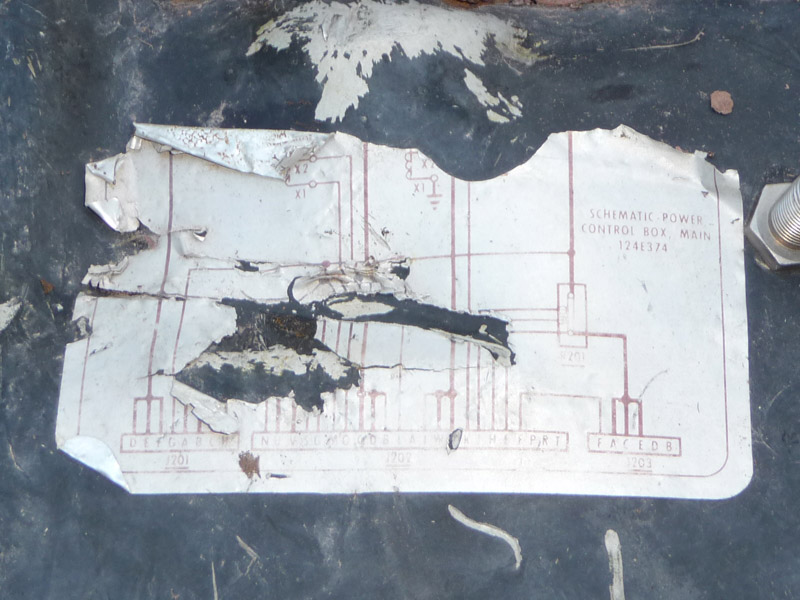
| It has part number 124E374.
|
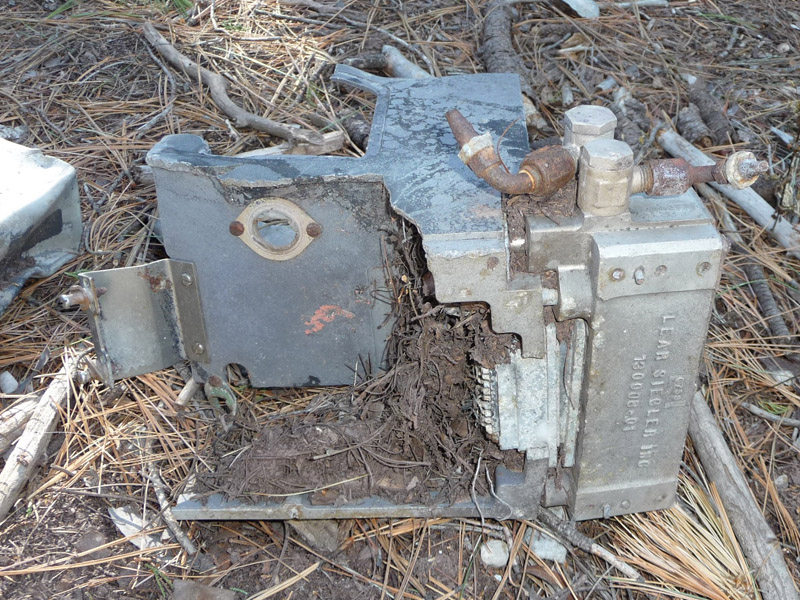
| Undetermined system by Lear Siegler. The cast number appears to be 130008-01
|
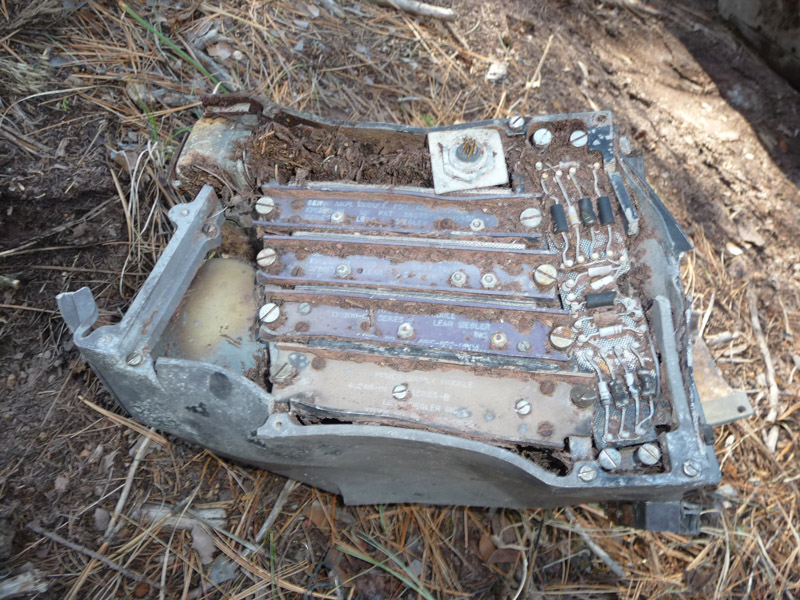
| A cast aluminum housing, with four colored bars inside. The top bar reads 'Servo Ampl Module', the lower bar 'Power Supply Module'. The other two have needles obstructing the designation. All bars are produced by Lear Siegler.
|
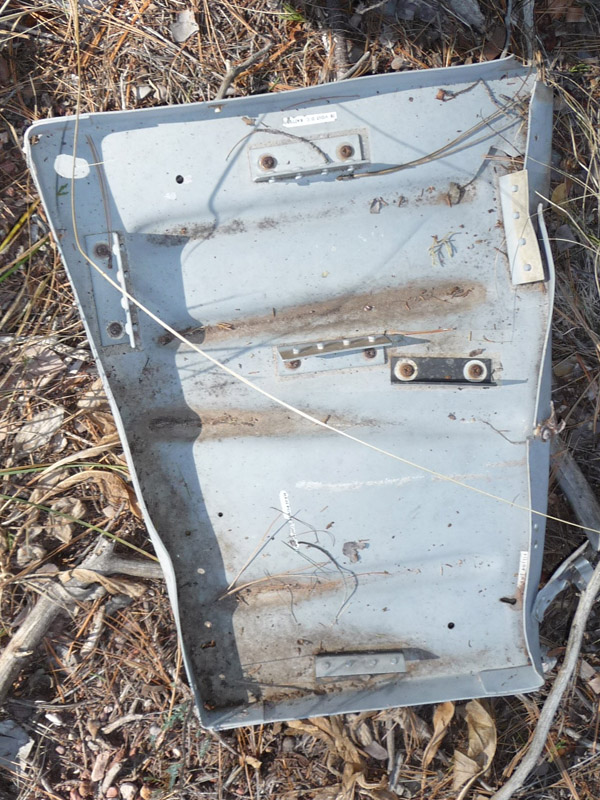
| Possibly an avionics tray?
|
In 2016, a friend of Leonard was in the area, a bit off-trail, and found another piece of the wreck.
In 2025, Barry Disbrow, a friend of Leonard, discovered a chaff pod uphill from the drone wreck, just below the crest of the canyon. Chaff material was also found, looking like strips of aluminum.
